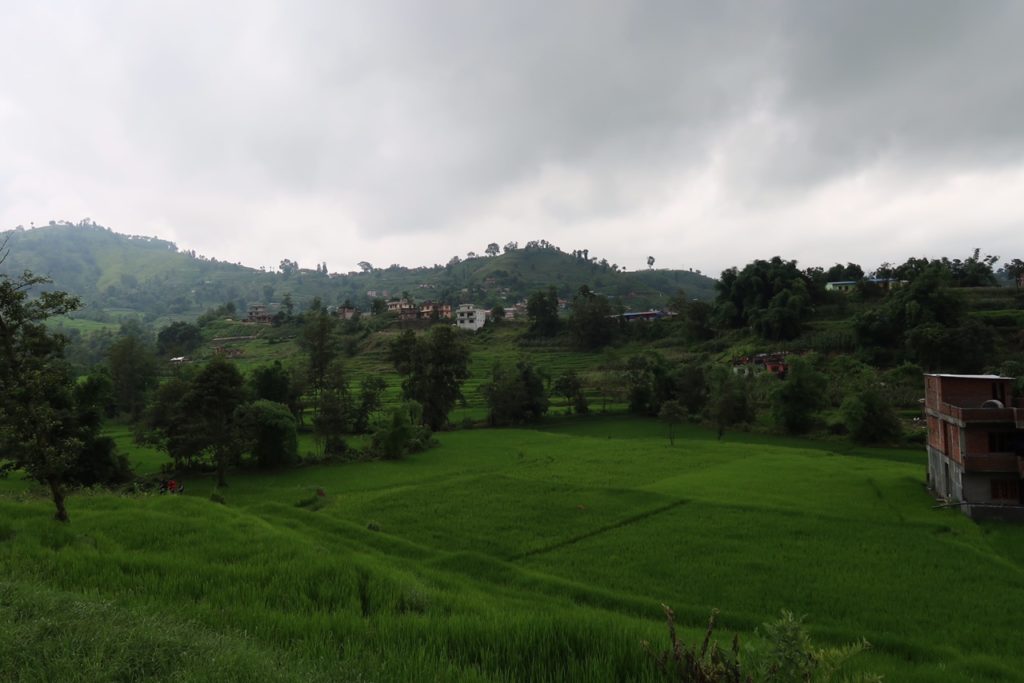6月29日はネパールでは、Asarアサール月の15日にあたり、Asar Pandraとしてお祝いし、ダヒチウラ Dahi Chiura を食べる習慣があるそうです。因みに2015年のAsar Pandraを説明したKathmandupostの記事では、
People across the country celebrated Asar Pandra, also known as Ropain Diwas, by planting paddy in their fields on Tuesday.
The day, which usually falls on the last week of June, is also observed as National Paddy Day. The celebration generally includes singing of traditional Asare Bhaka, dancing, splashing mud at each other and a feast of beaten rice and curd popularly known as ‘Dahi-Chiura’.
The day has a significant meaning in the country as paddy accounts for a larger portion of agricultural production in the country.
と紹介されています。池田市のネパール料理店「ネパールのごちそう jujudhau ズーズーダゥ」の店主カドカさんから、是非ダヒチウラを食べて下さいとのお誘いがありました。シンプルなダヒチウラを予想していましたが、他のお客様の尽力により、鹿と猪も料理に加わり豪華なサマエバジ Samay Baji で登場です。チウラに振りかける砂糖が添えられ、その上からダヒ(ヨーグルト)をかけて頂きます。ロティも焼いて下さいました。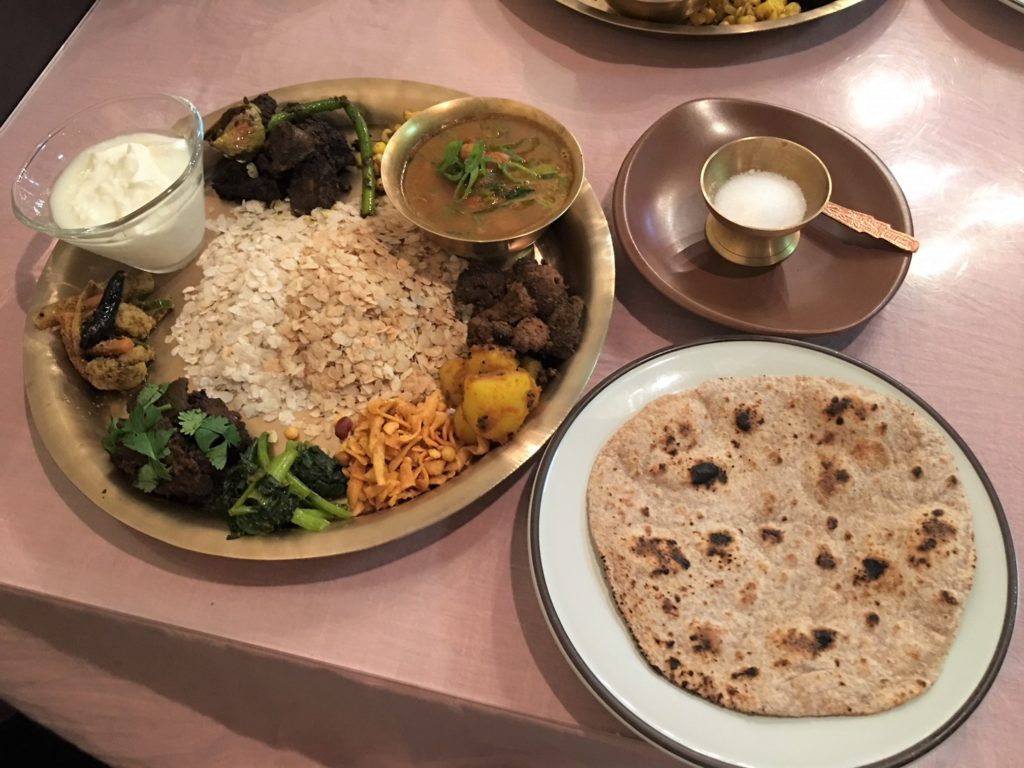 中央の2色のチウラを取り囲むように、10時の位置のダヒから時計回りに、
中央の2色のチウラを取り囲むように、10時の位置のダヒから時計回りに、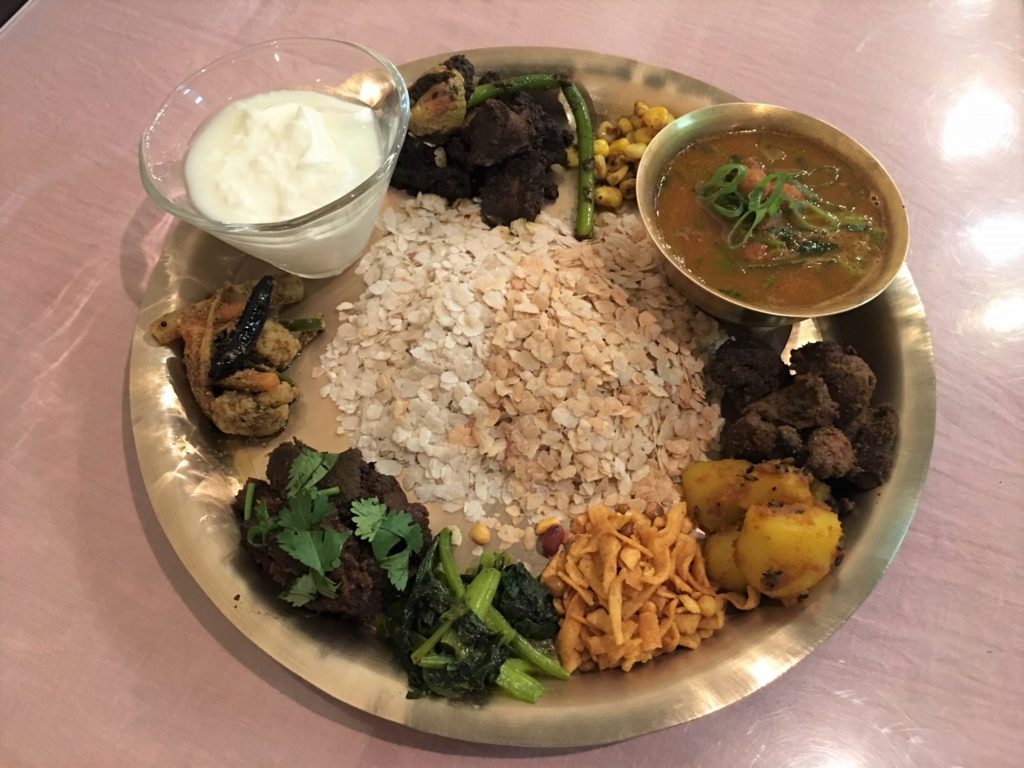 猪のブトン(肝、肺、胃)、
猪のブトン(肝、肺、胃)、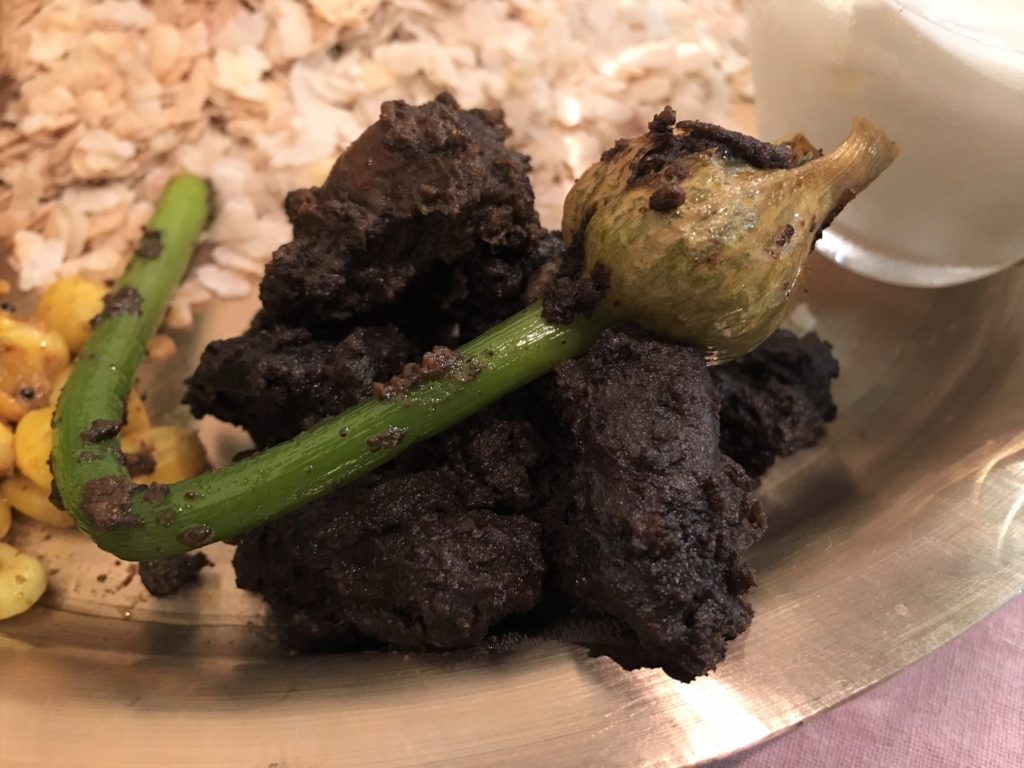 トウモロコシのアチャール、
トウモロコシのアチャール、
チャナ豆と大蒜の葉のタルカリ、
鹿肉のセクワ、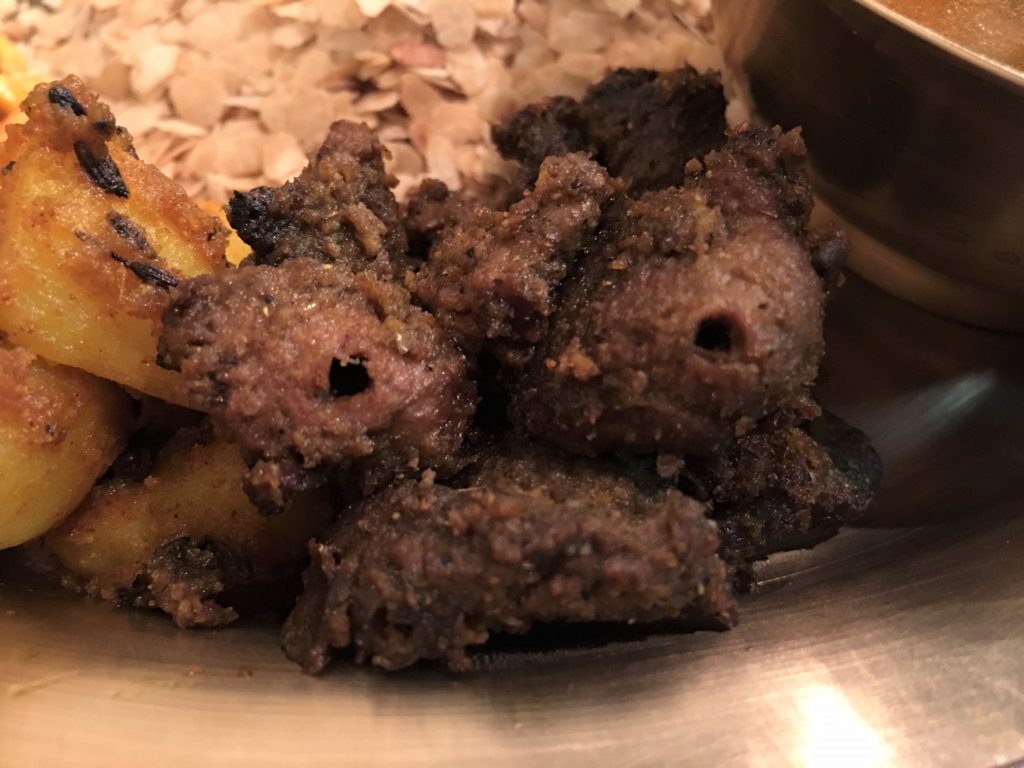 じゃが芋のアチャール、
じゃが芋のアチャール、
ダルマート、
青菜炒め、
鹿のブトン(肝、肺)、
カリフラワー、人参と唐辛子のアチャールが並びます。
このアチャールに仕立てられたカリフラワーの発酵具合が堪りませんでした。
サマエバジに合うのはネパールではチャンと言うことで、他のお客様が持ち込まれた「にごり酒」や、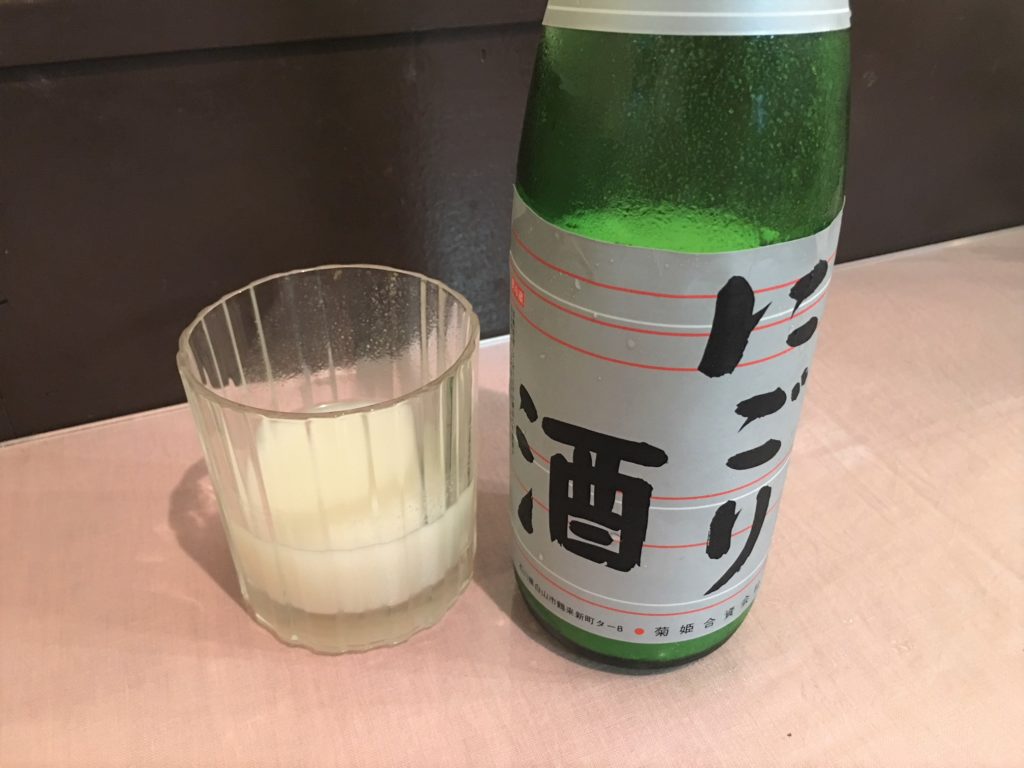
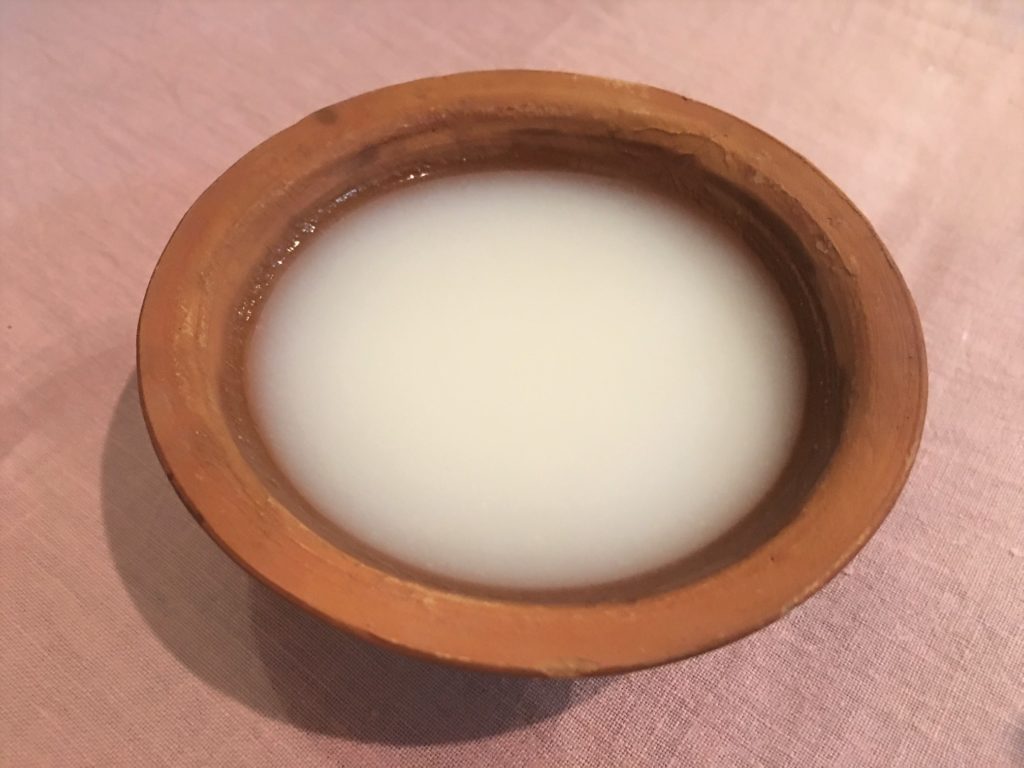 ロキシーを使った山桃のカクテル、
ロキシーを使った山桃のカクテル、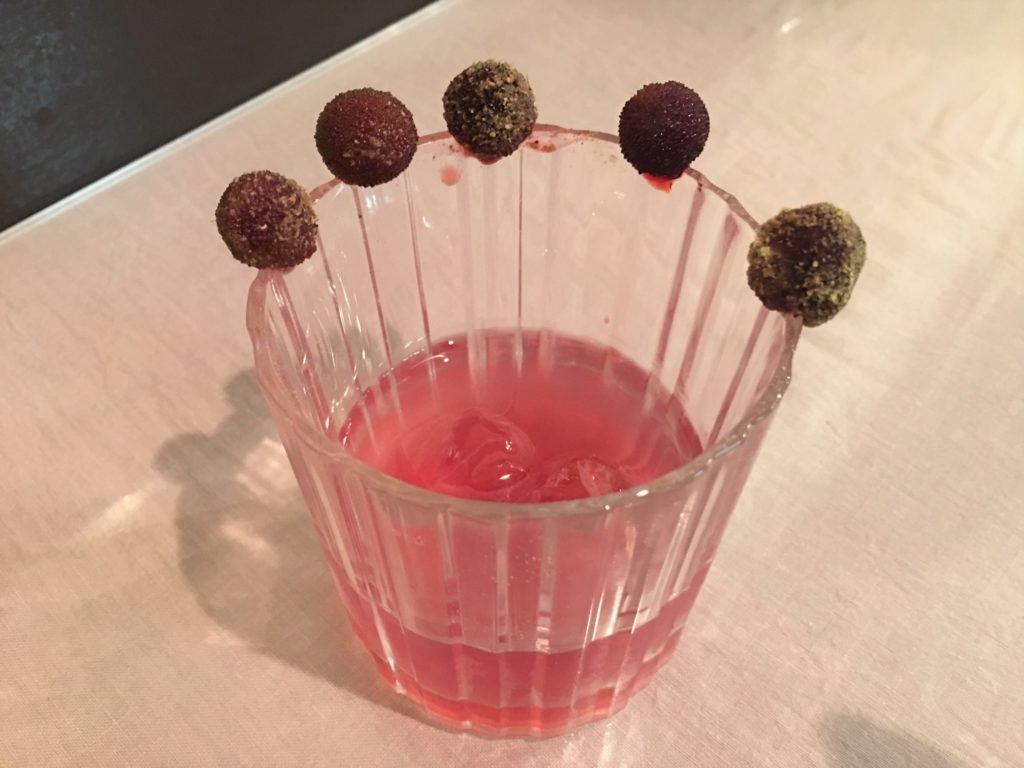 山桃のラッシーなども登場し、
山桃のラッシーなども登場し、 まさしくお祭りの宴の体を成しており、主役がダヒチウラであったことを忘れてしまいそうでした。
まさしくお祭りの宴の体を成しており、主役がダヒチウラであったことを忘れてしまいそうでした。
一つ疑問が湧きます。Asarアサール月の15日は、毎年だいたい同じ6月29日頃になるはず、ということは毎年田植えの時期は変わらないのでしょうか。日本では温暖化に伴い、暑さに強い米への品種改良が進み、それら晩生種に切り替えて栽培されるようになると、田植えの時期が遅くなってきます。一方で、コシヒカリなどの人気品種はそれらに比べ早生が多く、そちらを選択して栽培する農家も出てきます。同じ地方でも、田植え時期が選択する品種によって大きく異なるというのが、日本の米栽培の現状です。ネパールの米栽培の課題の一つが生産性の向上、及び消費者の好みの変化に伴う品質の改善で有り、それを目的とする品種改良や耕作支援も行われており、従来種と田植えの時期が変わらないのかが知りたいところです。
RICE VARIETAL MAPPING IN NEPAL: IMPLICATION FOR DEVELOPMENT AND ADOPTION Government of Nepal, Ministry of Agricultural Development, Department of Agliculture, Crop Development Directorate
の記述を少し拾ってみました。
2.5.1 National Rice Day
Recognizing the importance of rice in different aspects of life, the Government of Nepal on 14th December 2004 (29th Mangsir 2061 B.S.) officially declared Asar 15 (June 29) of each year as “National Rice Day” with the aim to create awareness about the importance of rice in the national economy and general well being of the people in Nepal. According to Hindu cultural norm, Ashar 15 is considered as the auspicious day to start rice transplanting for the year. The day also marks a famous festival which is celebrated by singing folk songs, dancing and eating flattened rice mixed with curd. The recipe is popularly called as “Dahi Chiura”. (略)
2.5.2 Fine and Aromatic Rice Mission
Nepalese food habit is being gradually shifted towards fine and aromatic rice from coarse rice. As a result rice market transaction is moving to the fine rice. The rice traders try to sell even cheap coarse rice converting into fine rice through high degree of policing for higher price. These days rice traders are attracting consumers by branding any type of rice as Jiramasino (fine rice). Fine and aromatic rice in the Nepalese super market and departmental store is on the rise for past few years. At this backdrop, considering the increasing demand of fine and aromatic rice, GoN has launched the first mission program on “Fine and Aromatic Rice” in 20 districts (Terai-17 and hills-3) from the year 2015. This mission program aims at increasing area, production and productivity of fine and aromatic rice in Nepal and reducing imports. This program targets to cultivate fine and aromatic rice in 7,500 ha and attain yield at 3 t/ha. The major activities of this program are 50% subsidies in foundation seed, 75% in commercial or improved seed, 100% in green manure (Sesbania aculeata) crop seed
and provision of Zinc Sulphate for the reclamation of Zinc deficiency in rice field.
お店で頂ける料理の数々は
→「jujudhau ズーズーダゥ(池田市)ネパールのごちそう」
ネパールのごちそう
jujudhau
ズーズーダゥ
池田市室町1-3
https://ja-jp.facebook.com/jujudhaunepal/
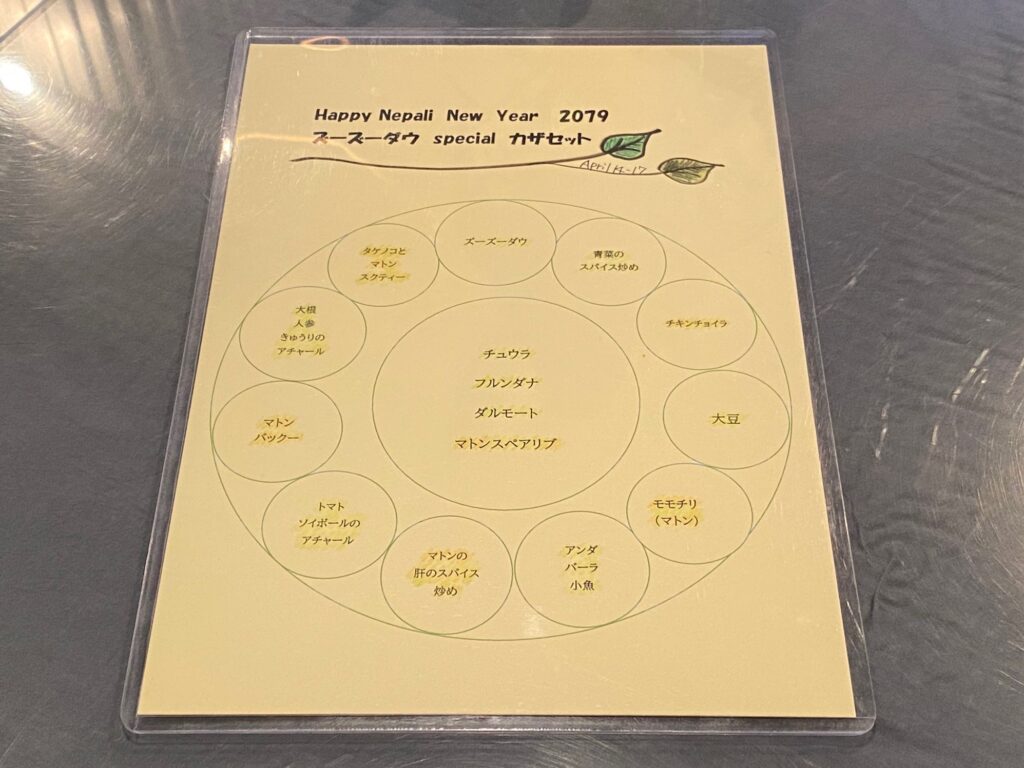 お店の SNS で告知の上、準備の都合のため完全予約制とされました。
お店の SNS で告知の上、準備の都合のため完全予約制とされました。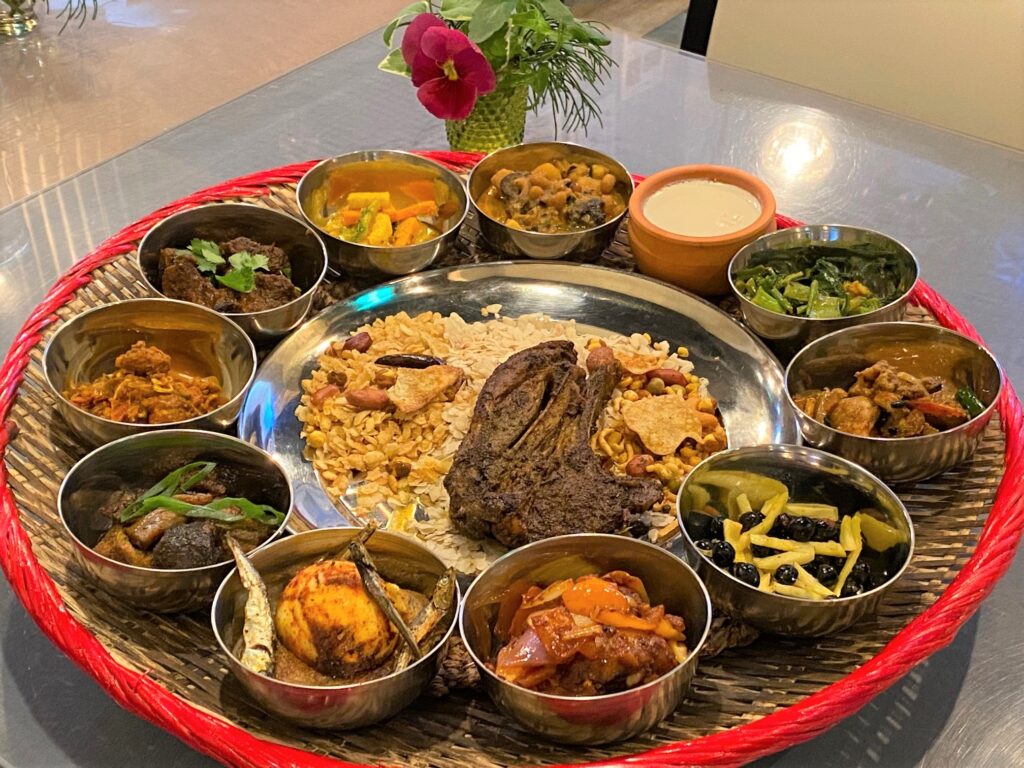 中央のチウラ Chura、ダルモート Dal moth、フランダナ Fhuran dana の上に、マトンスペアリブが存在感を示しています。
中央のチウラ Chura、ダルモート Dal moth、フランダナ Fhuran dana の上に、マトンスペアリブが存在感を示しています。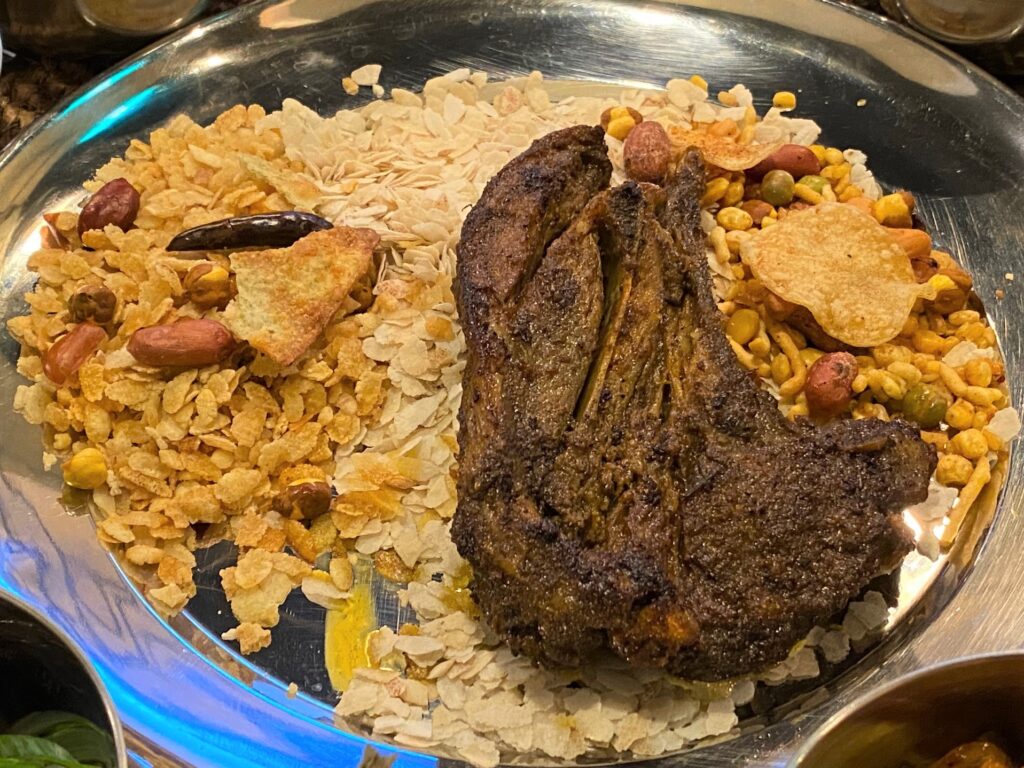 その周りに、お祝い事に欠かせないサグン Sagun (バーラ Bara、玉子 Anda、小魚 Sidra Macha のセット)から時計回りに、
その周りに、お祝い事に欠かせないサグン Sagun (バーラ Bara、玉子 Anda、小魚 Sidra Macha のセット)から時計回りに、 マトンのブタン Bhutan、
マトンのブタン Bhutan、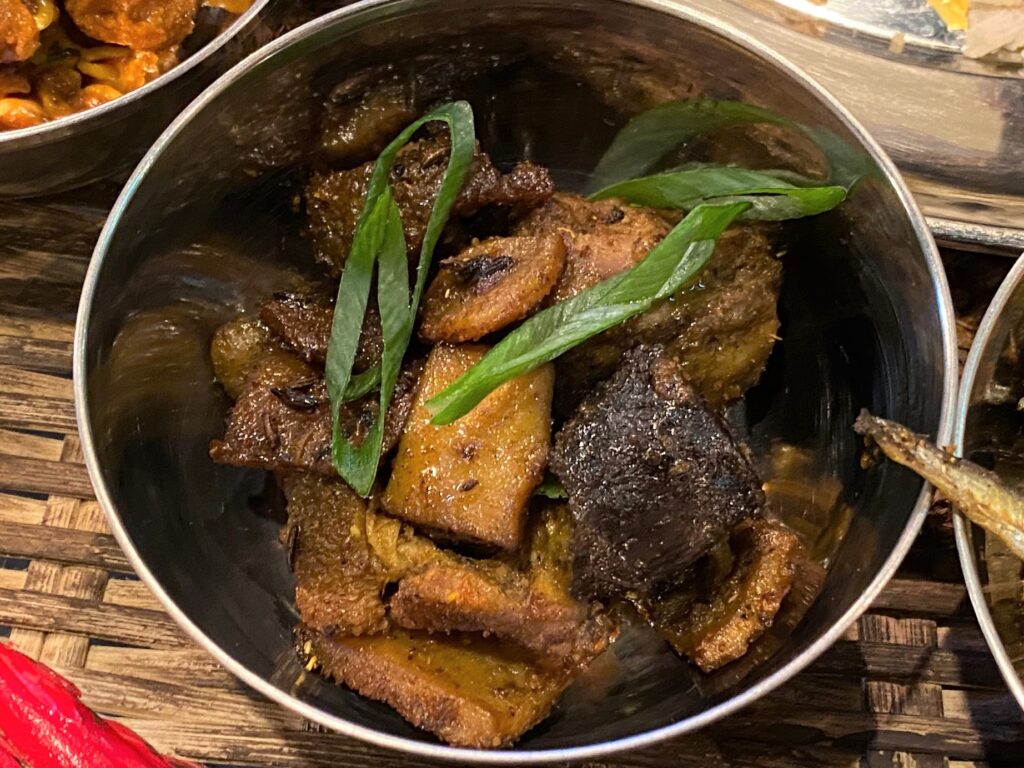 トマトとマショウラ、発芽させた豆のアチャール Golbheda ra maseura ra tusa umreko gedagudi ko achar、
トマトとマショウラ、発芽させた豆のアチャール Golbheda ra maseura ra tusa umreko gedagudi ko achar、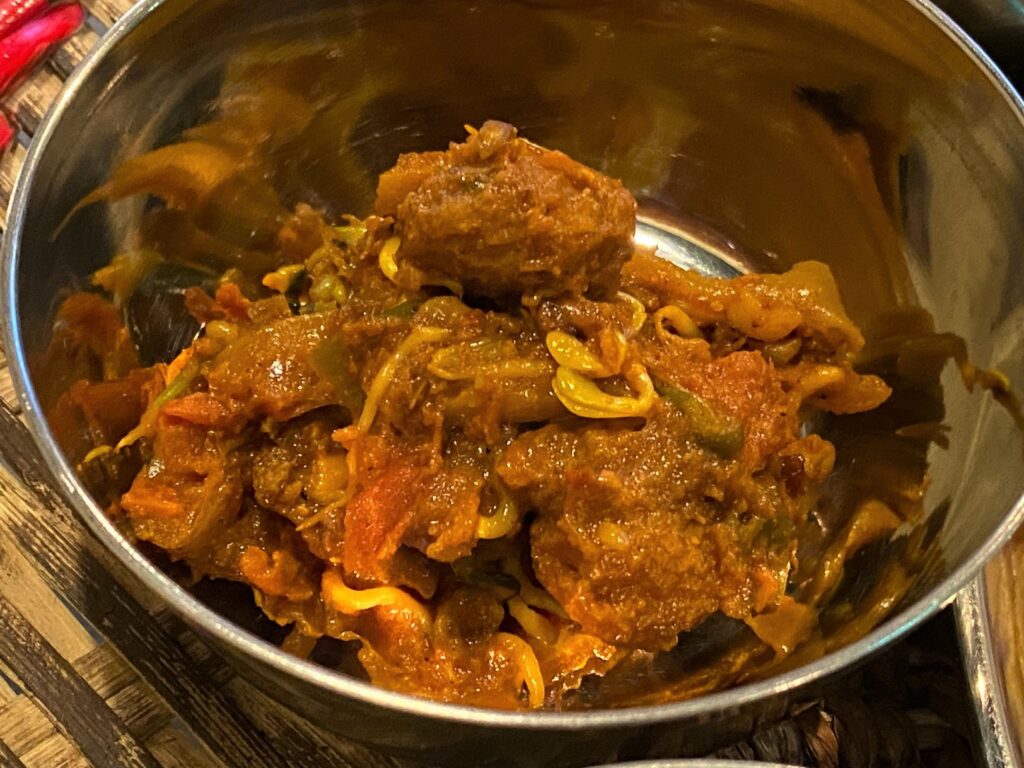 マトンパック Pakku、
マトンパック Pakku、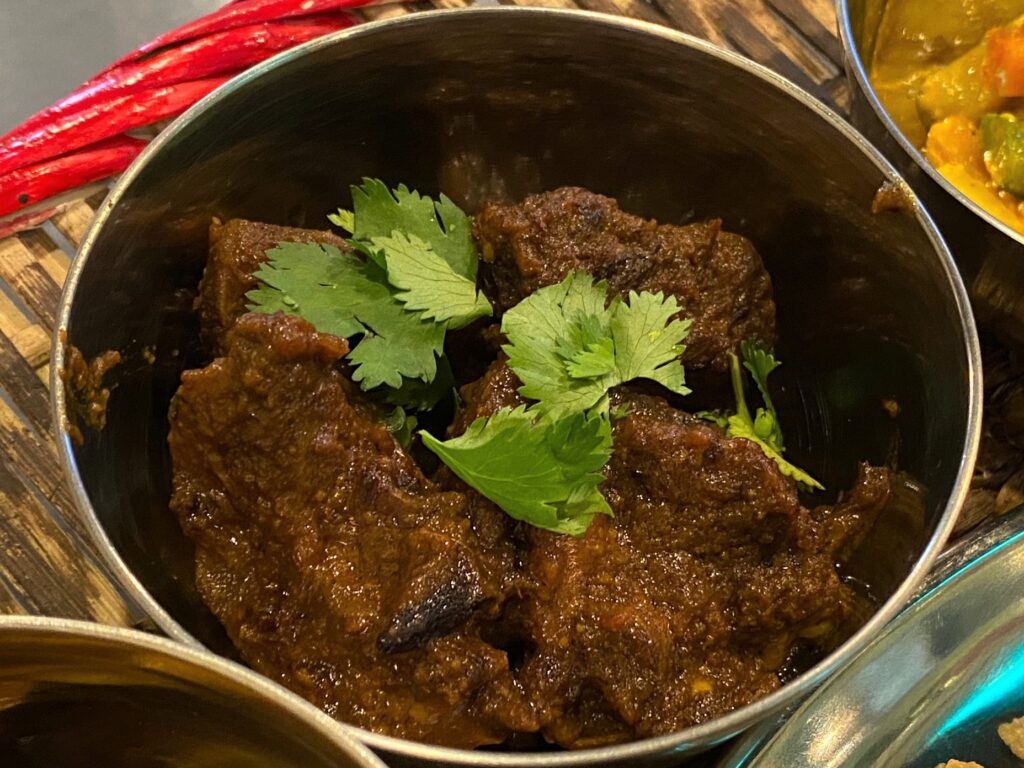 大根、人参、胡瓜のアチャール Mula ra gajar ra kakro ko achar、
大根、人参、胡瓜のアチャール Mula ra gajar ra kakro ko achar、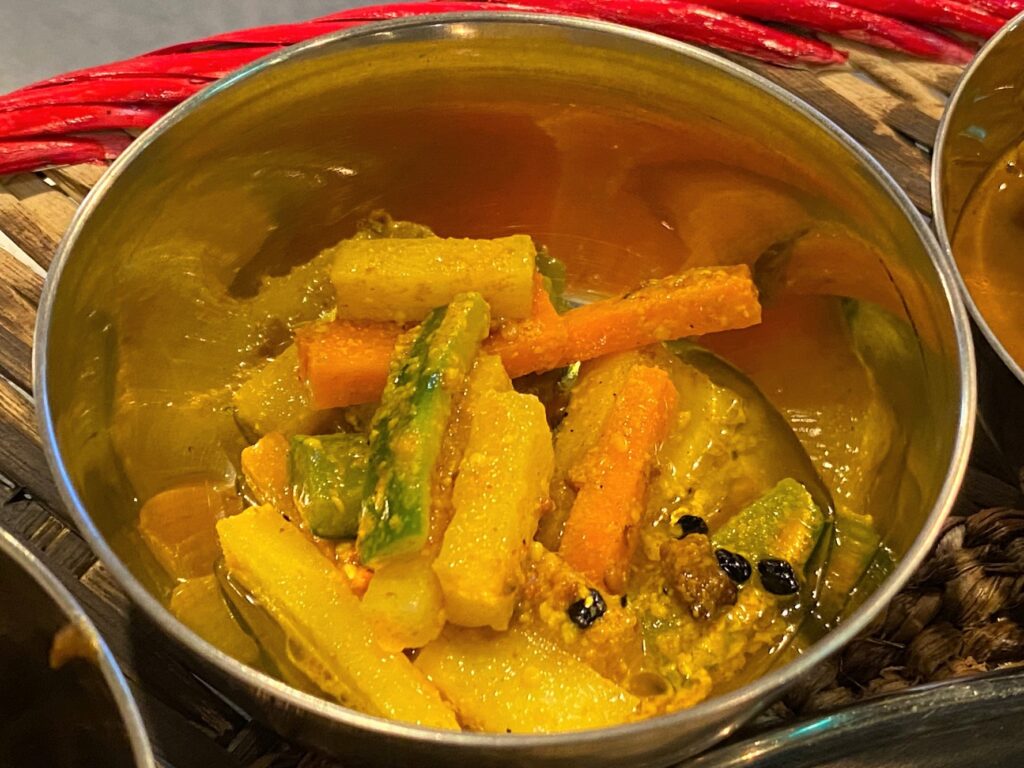 マトンスクティ入りのアルタマボリ Alu tama bodi skuti、
マトンスクティ入りのアルタマボリ Alu tama bodi skuti、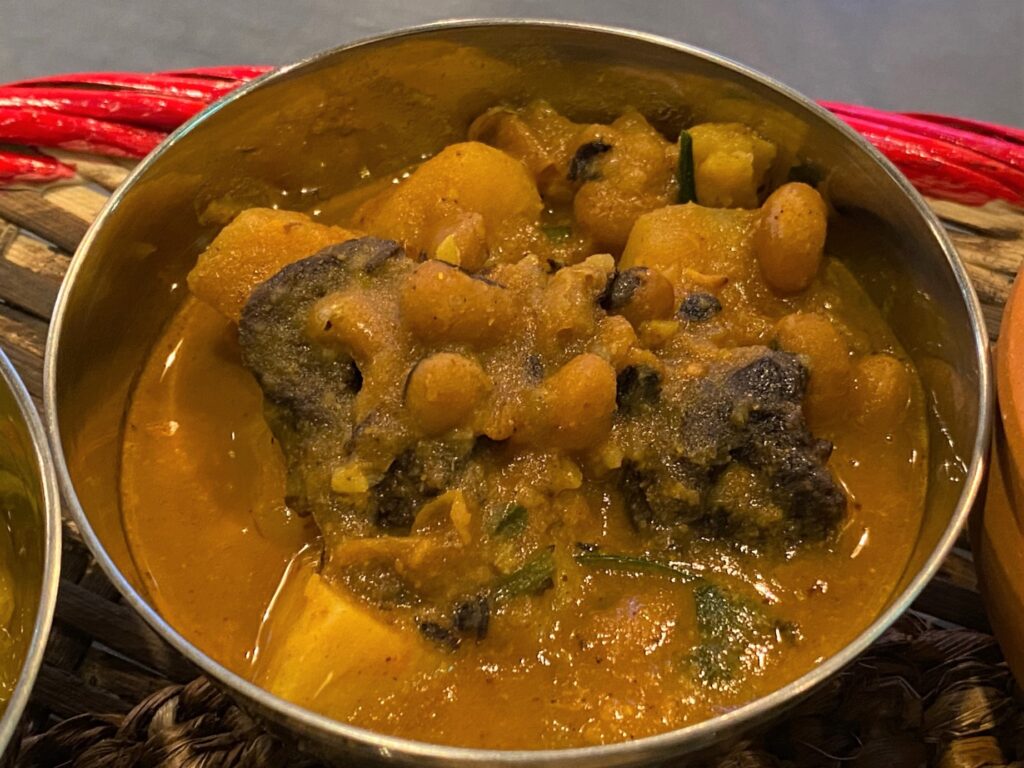 ズーズーダゥ Juju dhau、
ズーズーダゥ Juju dhau、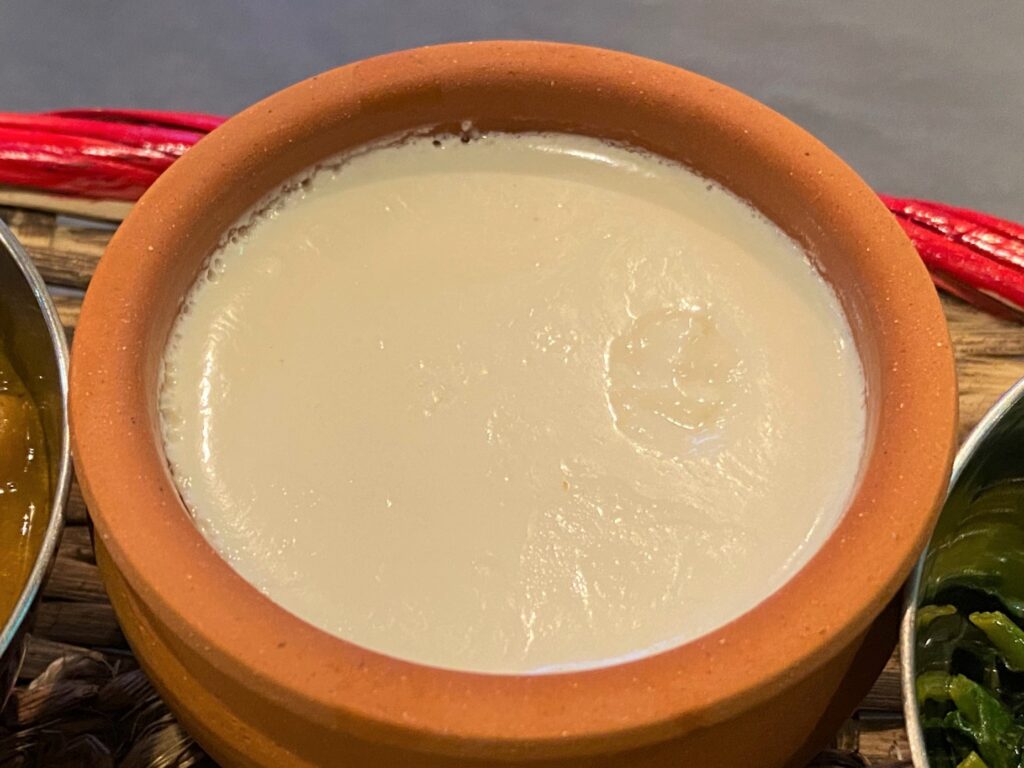 青菜のスパイス炒め Saag bhuteko、
青菜のスパイス炒め Saag bhuteko、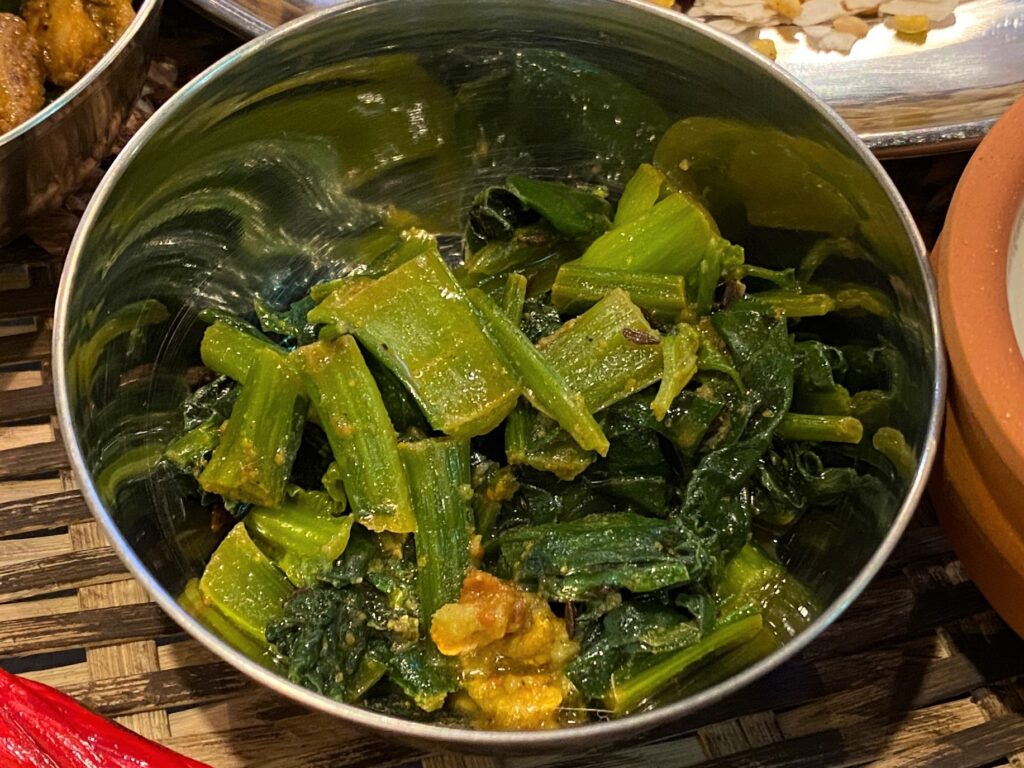 チキンチョイラ Choila、
チキンチョイラ Choila、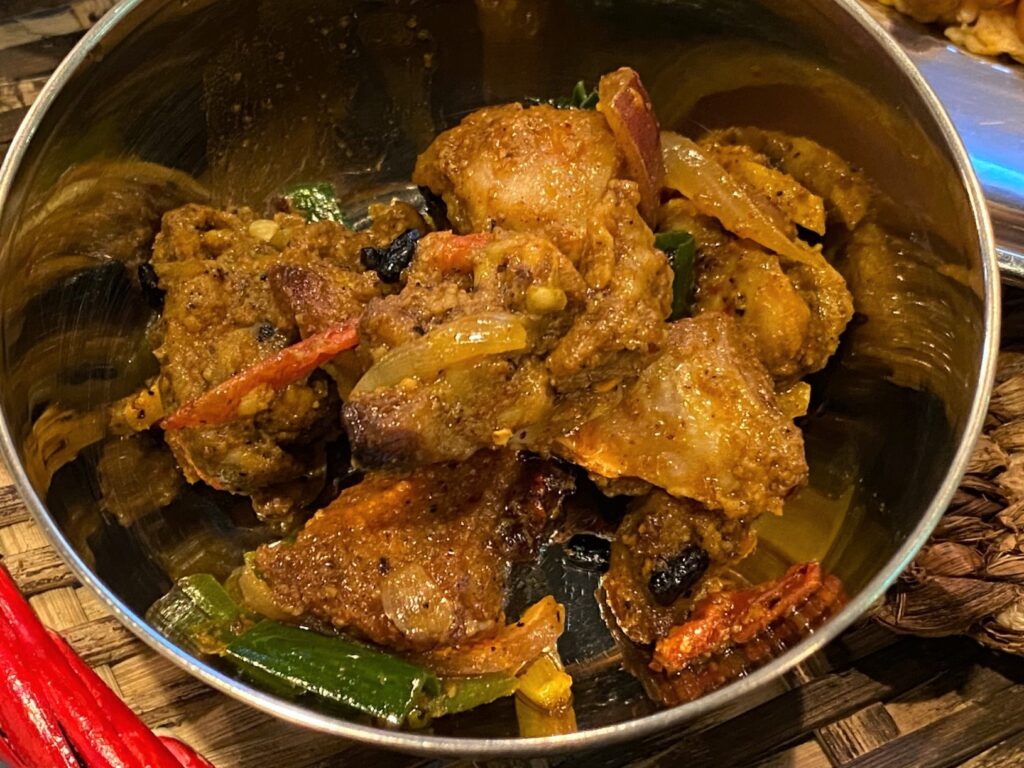 バトマスサデコ Bhatmas sadeko、
バトマスサデコ Bhatmas sadeko、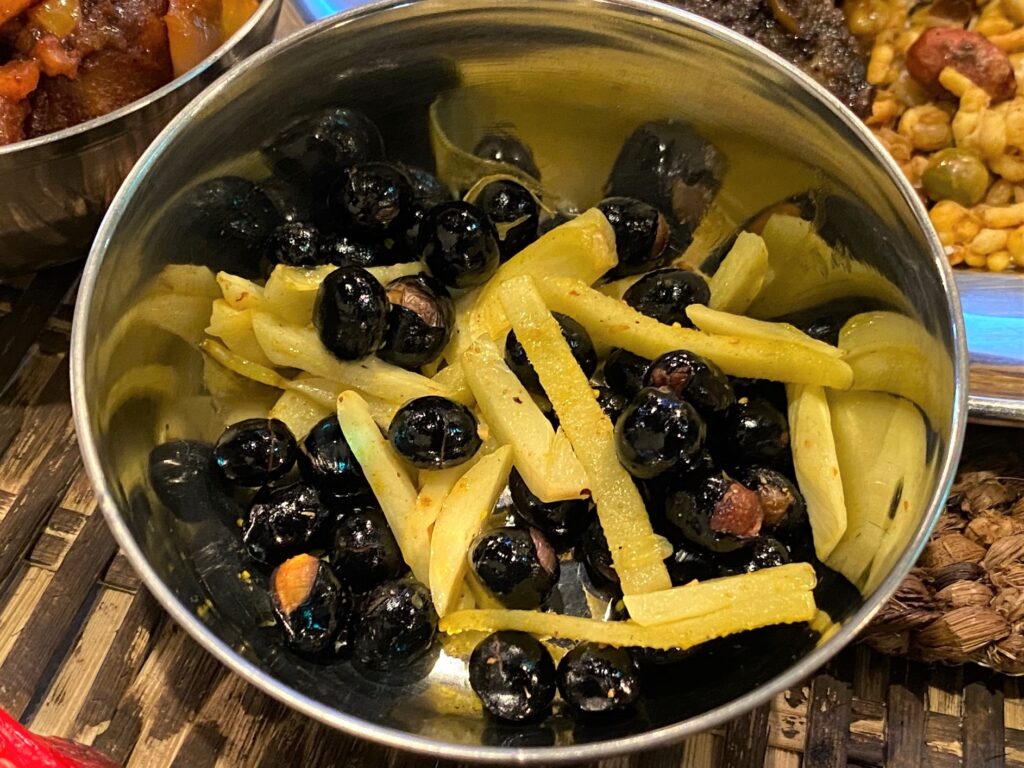 マトンモモチリ Momo chili が並びました。
マトンモモチリ Momo chili が並びました。 食後にチヤ Chiya も頂きました。
食後にチヤ Chiya も頂きました。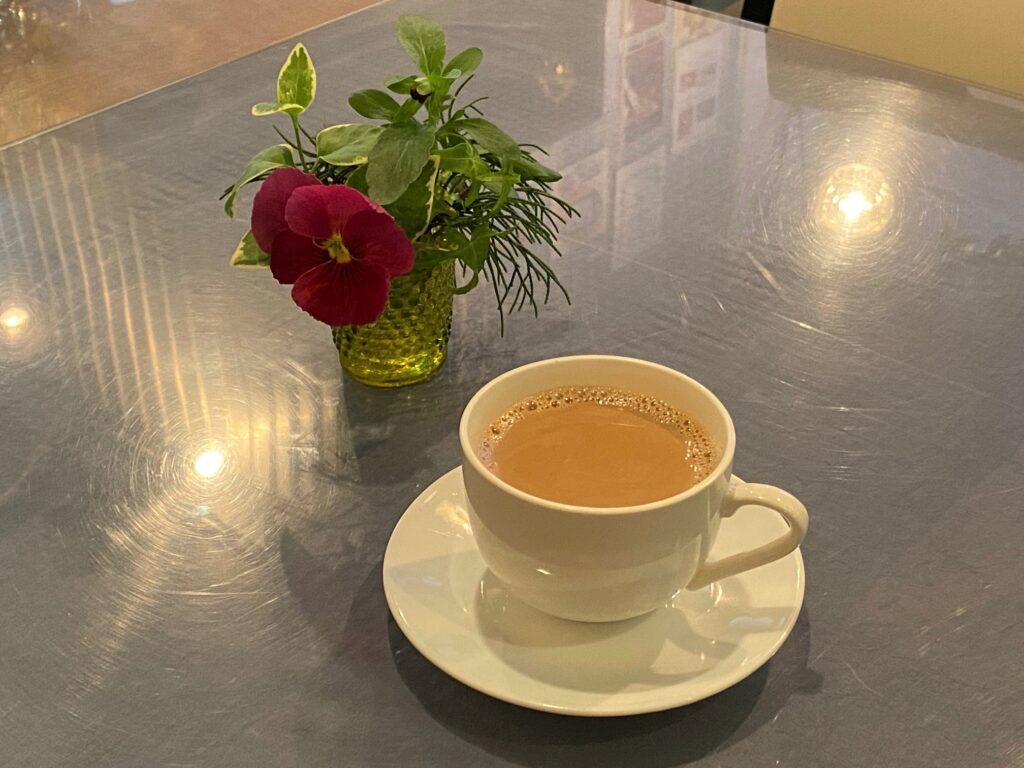

 小さなカトリでアルタマボリ(じゃが芋と発酵タケノコ、ささげ)が添えられています。
小さなカトリでアルタマボリ(じゃが芋と発酵タケノコ、ささげ)が添えられています。 追加でチョウメンもお願いしました。
追加でチョウメンもお願いしました。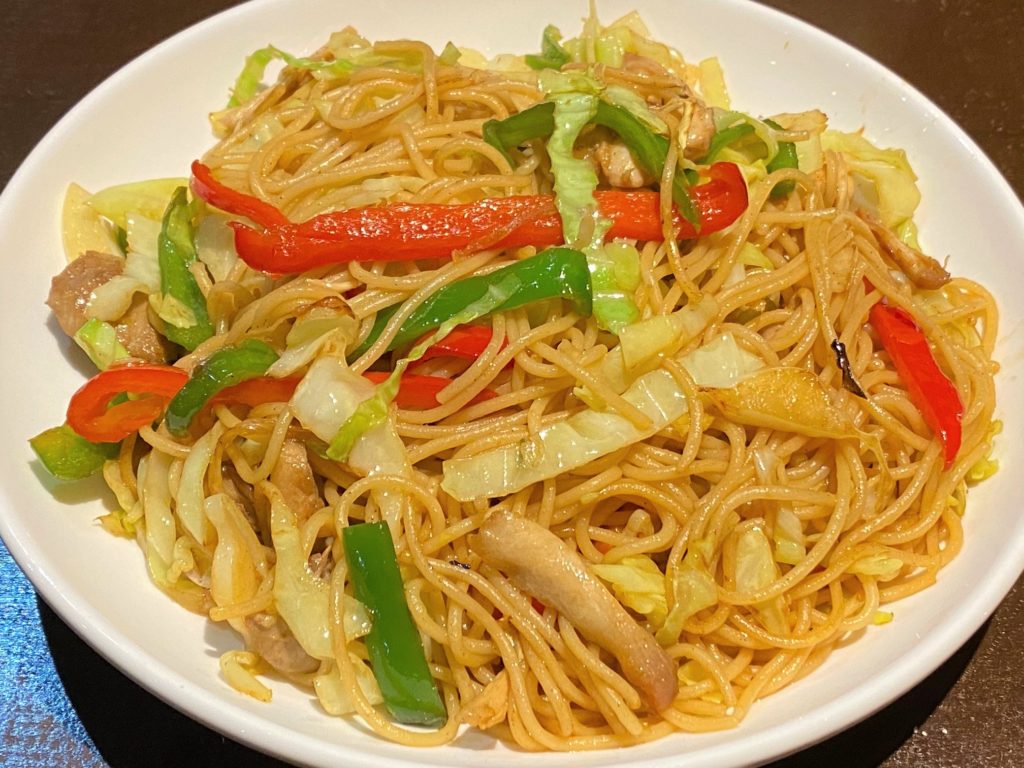 食後にチヤを頂きました。
食後にチヤを頂きました。
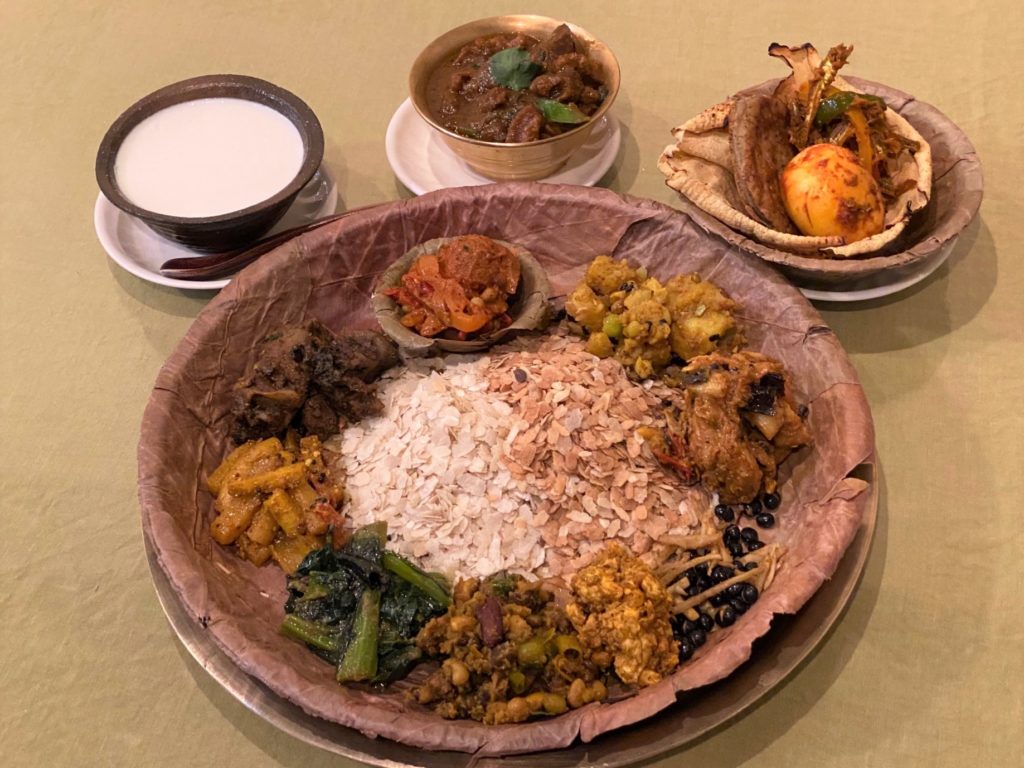
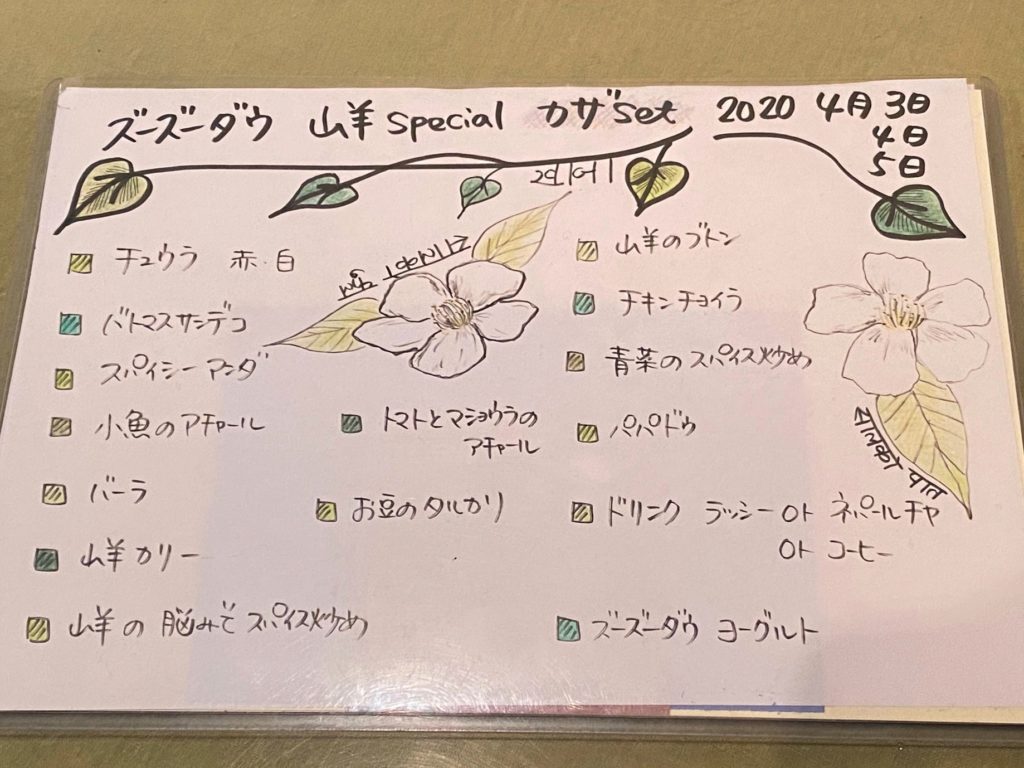 お祭りには欠かせない山羊肉 Khasi ko Masu、
お祭りには欠かせない山羊肉 Khasi ko Masu、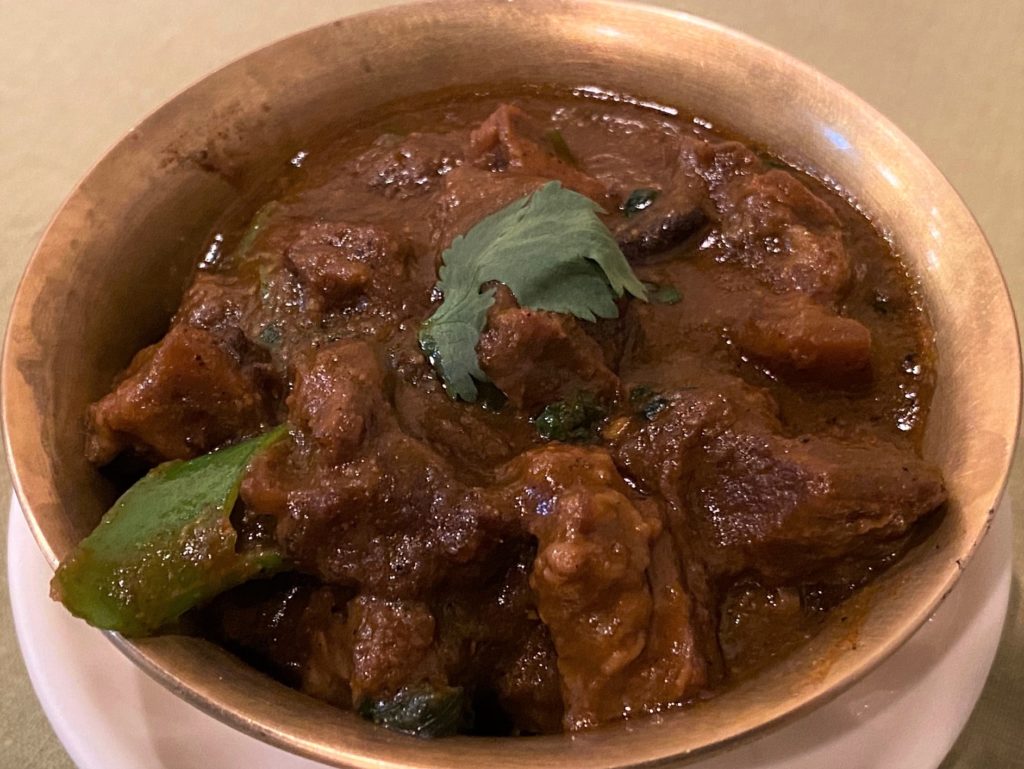
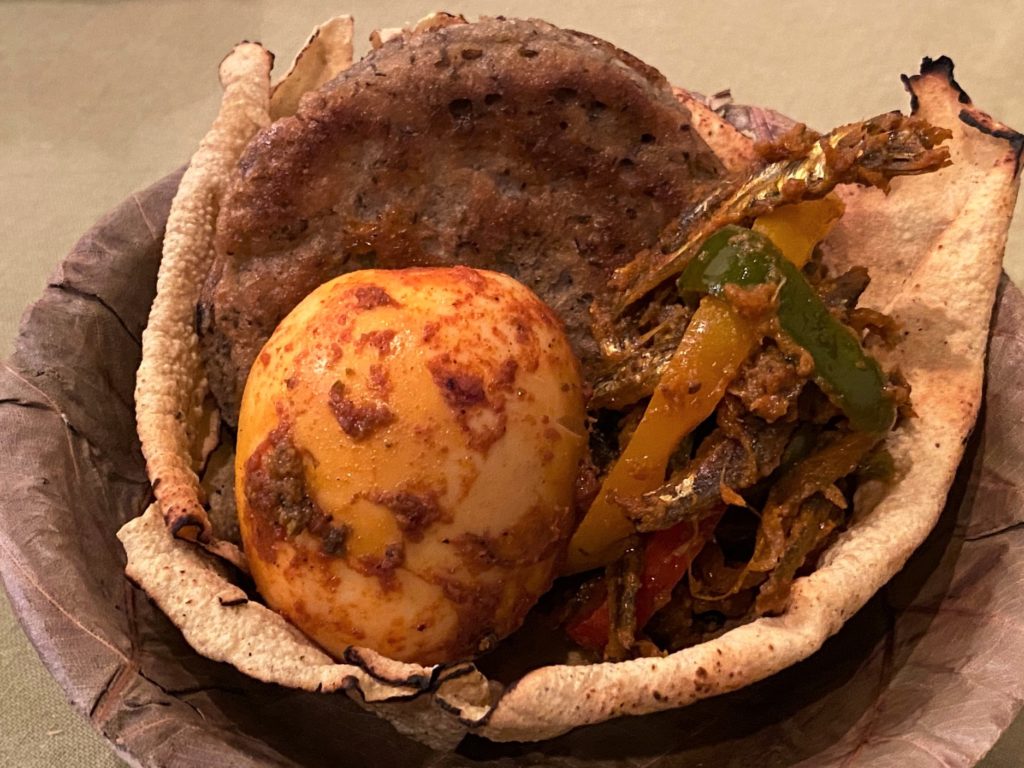 大皿にはチウラのまわりをカザの品々が取り囲みます。
大皿にはチウラのまわりをカザの品々が取り囲みます。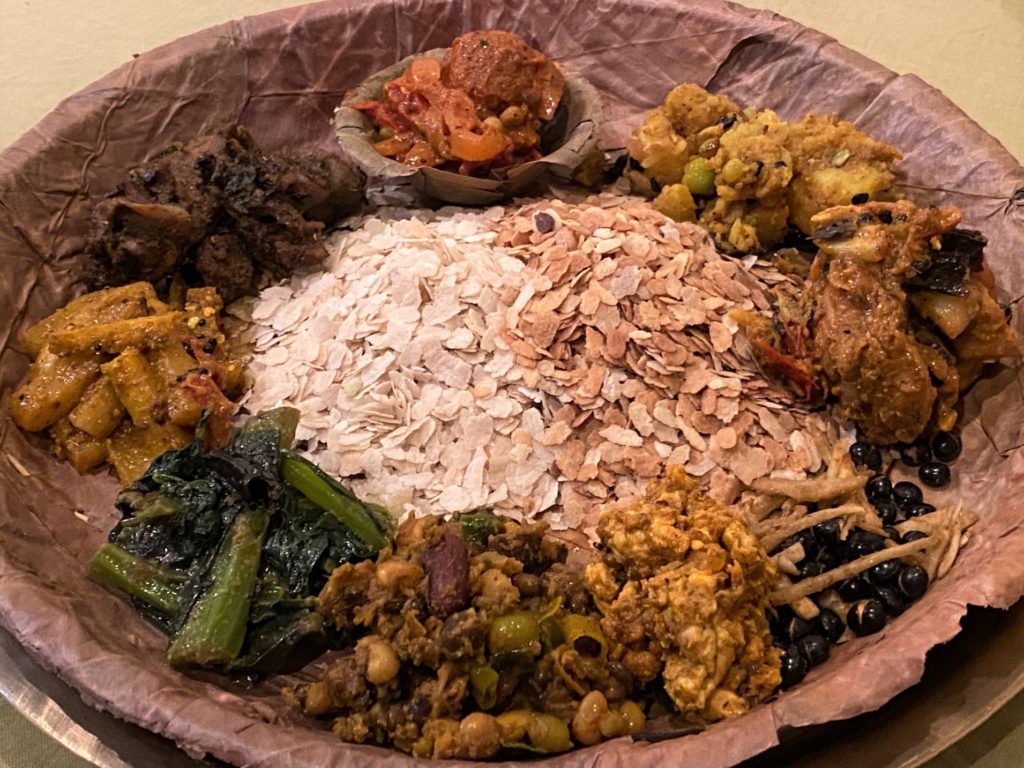
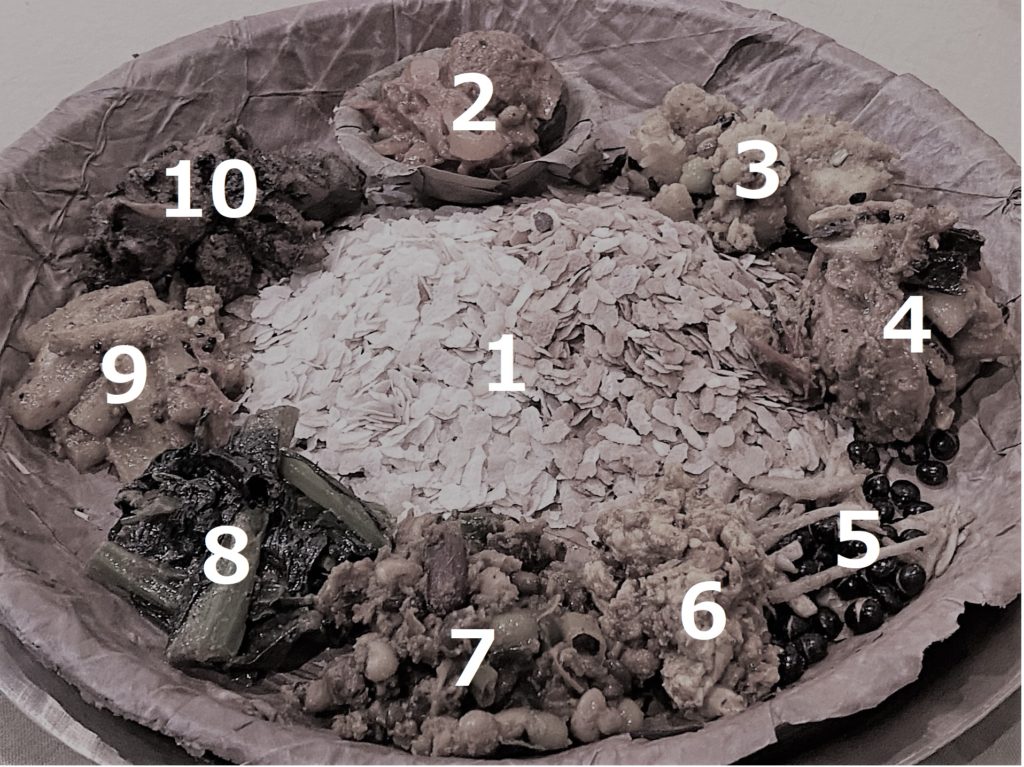 1. 2種類のチウラ、2. 自家製マショウラとトマトのアチャール、3. じゃが芋とえんどう豆のアチャール、4. チキンチョイラ、5. 大豆、バトマスサンデコ、6. 山羊の脳、ギディ、7. 沢山の種類の豆のタルカリ、8. 青菜炒め、9. 大根のアチャール、10. 山羊の内臓、ブトンと並びました。豆のタルカリはクワティ Kwati ko Jhol の汁なしバージョンです。
1. 2種類のチウラ、2. 自家製マショウラとトマトのアチャール、3. じゃが芋とえんどう豆のアチャール、4. チキンチョイラ、5. 大豆、バトマスサンデコ、6. 山羊の脳、ギディ、7. 沢山の種類の豆のタルカリ、8. 青菜炒め、9. 大根のアチャール、10. 山羊の内臓、ブトンと並びました。豆のタルカリはクワティ Kwati ko Jhol の汁なしバージョンです。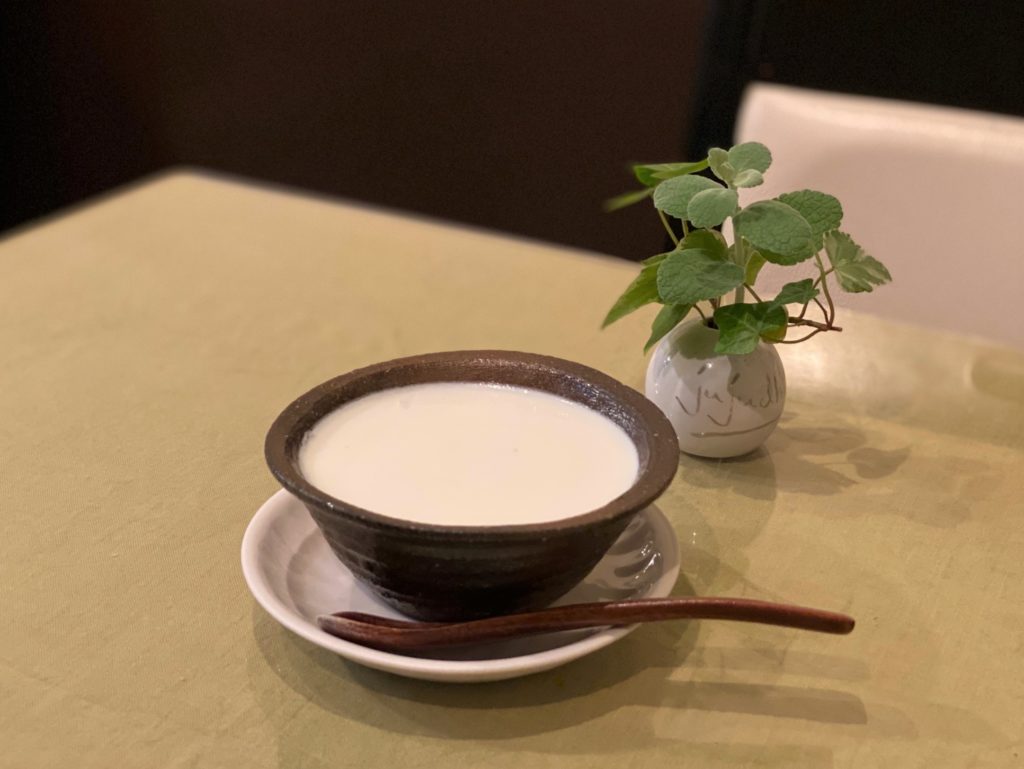 食後にチヤも頂きました。
食後にチヤも頂きました。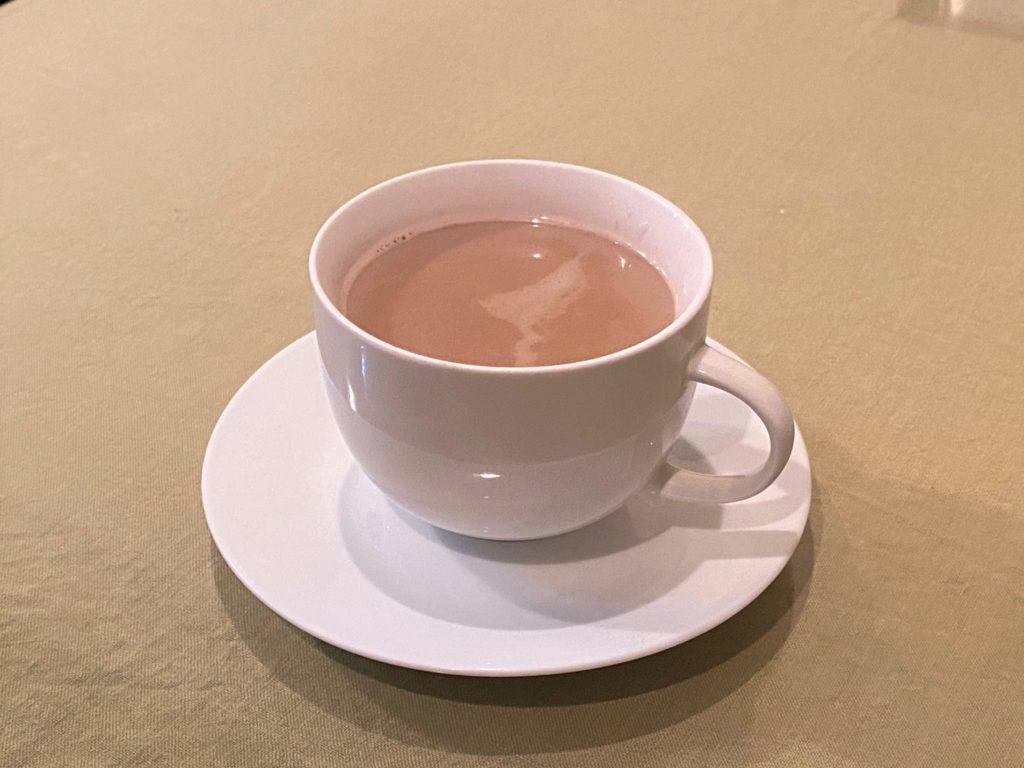

 カザを頂く時は、ロキシー Raksi も頂きたくなります。アマラ Amala (Amla) 入りのロキシーをお願いしました。
カザを頂く時は、ロキシー Raksi も頂きたくなります。アマラ Amala (Amla) 入りのロキシーをお願いしました。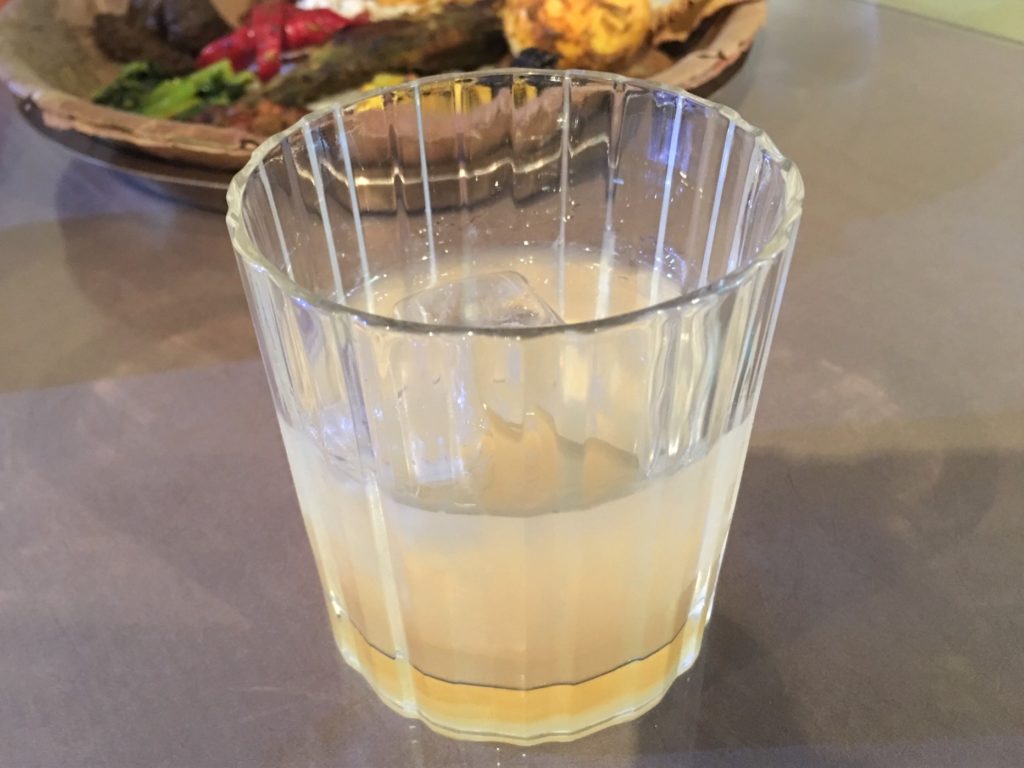 骨付きマトンカリーも添えられ、
骨付きマトンカリーも添えられ、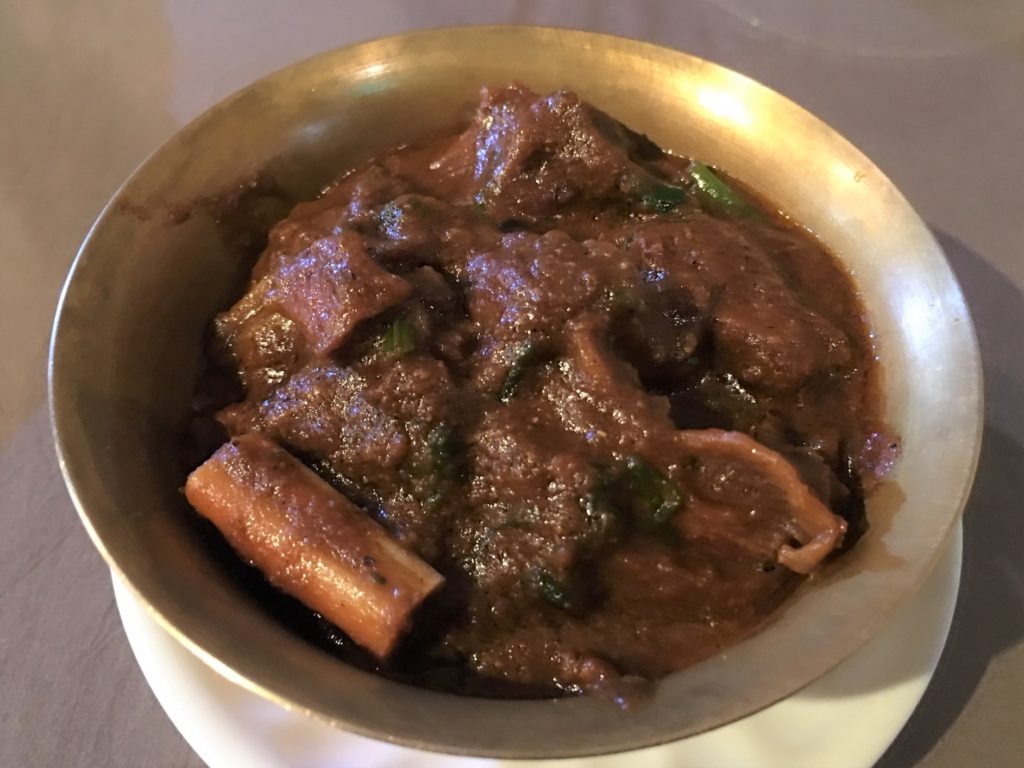 いつもながらの趣向が凝らされた品数豊富な一皿です。
いつもながらの趣向が凝らされた品数豊富な一皿です。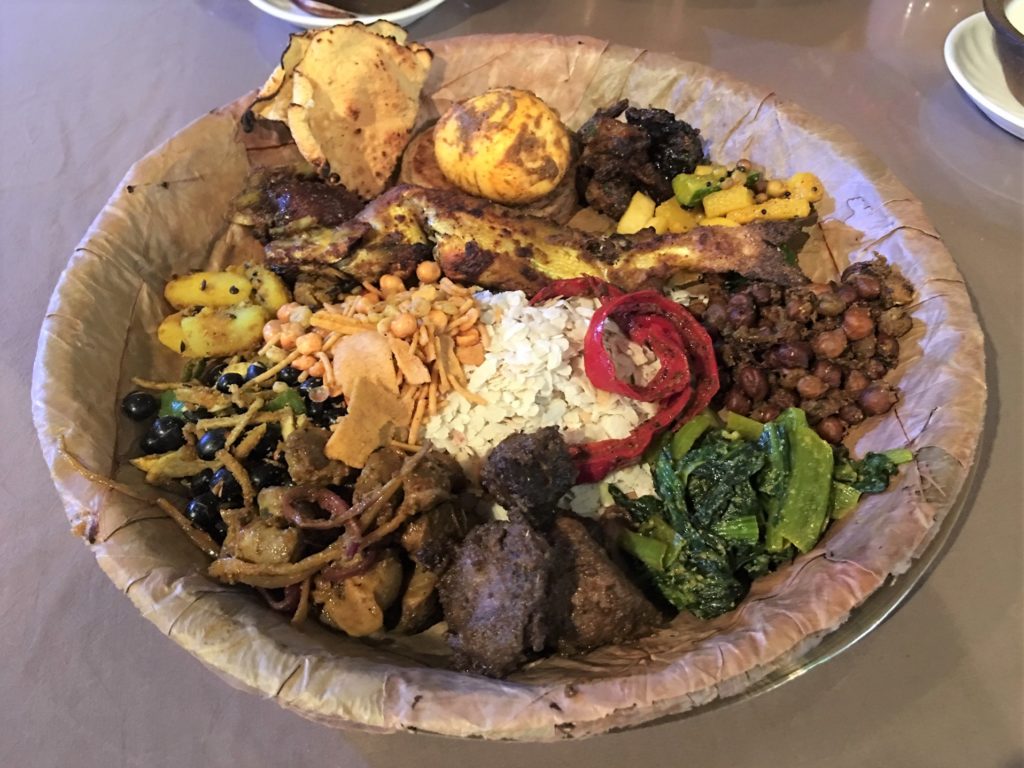
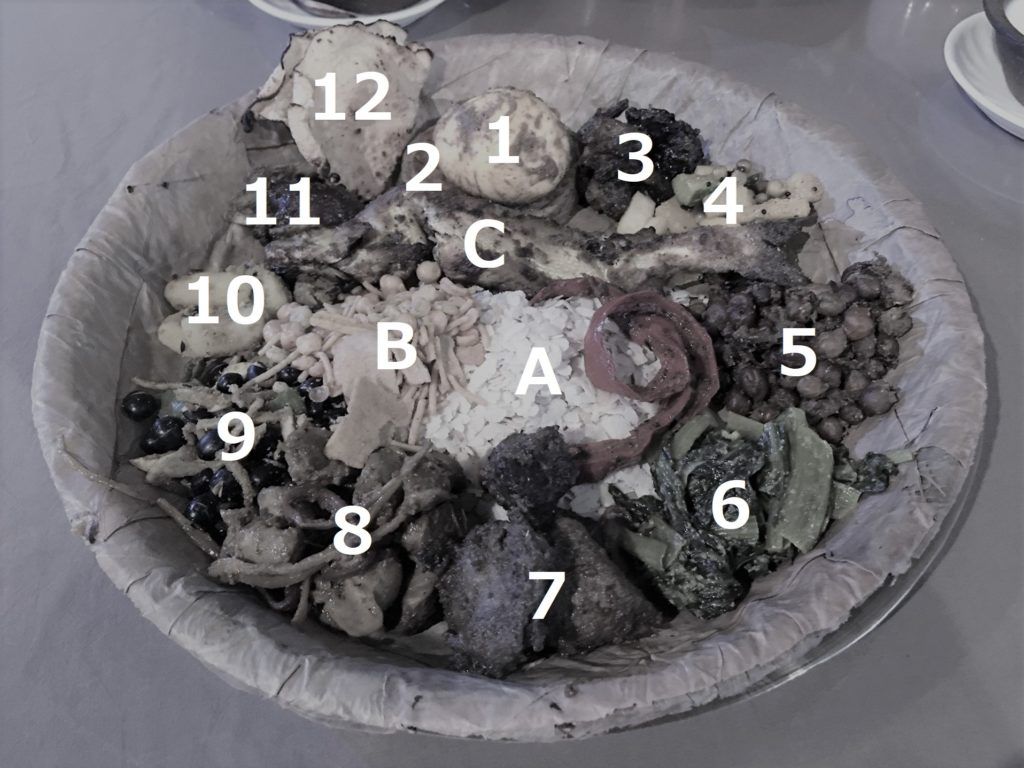 A. チウラ、B. ダルモートの周りを、C. 鮎のタンドール焼き、1. スパイシー卵、2. バラ、3. 水牛のスクティのセクワ、4. 大根、胡瓜、えんどう豆、5. カロチャナ、6. サグ、7. マトンのセクワ、8. ブトン(砂肝)、9. バトマスサデコ(大豆)、10. アルジラ(じゃが芋)、11. デーツのアチャール、12. パパドゥが並んで囲みます。時々魚のタンドール焼きを楽しむことが出来ますが、今回は鮎が登場です。メニューには書かれていない、水牛のスクティ (Buff Skuti) は自家製とのことで、セクワとして調理されています。
A. チウラ、B. ダルモートの周りを、C. 鮎のタンドール焼き、1. スパイシー卵、2. バラ、3. 水牛のスクティのセクワ、4. 大根、胡瓜、えんどう豆、5. カロチャナ、6. サグ、7. マトンのセクワ、8. ブトン(砂肝)、9. バトマスサデコ(大豆)、10. アルジラ(じゃが芋)、11. デーツのアチャール、12. パパドゥが並んで囲みます。時々魚のタンドール焼きを楽しむことが出来ますが、今回は鮎が登場です。メニューには書かれていない、水牛のスクティ (Buff Skuti) は自家製とのことで、セクワとして調理されています。 苺ラッシーや、苺焼酎も頂きました。
苺ラッシーや、苺焼酎も頂きました。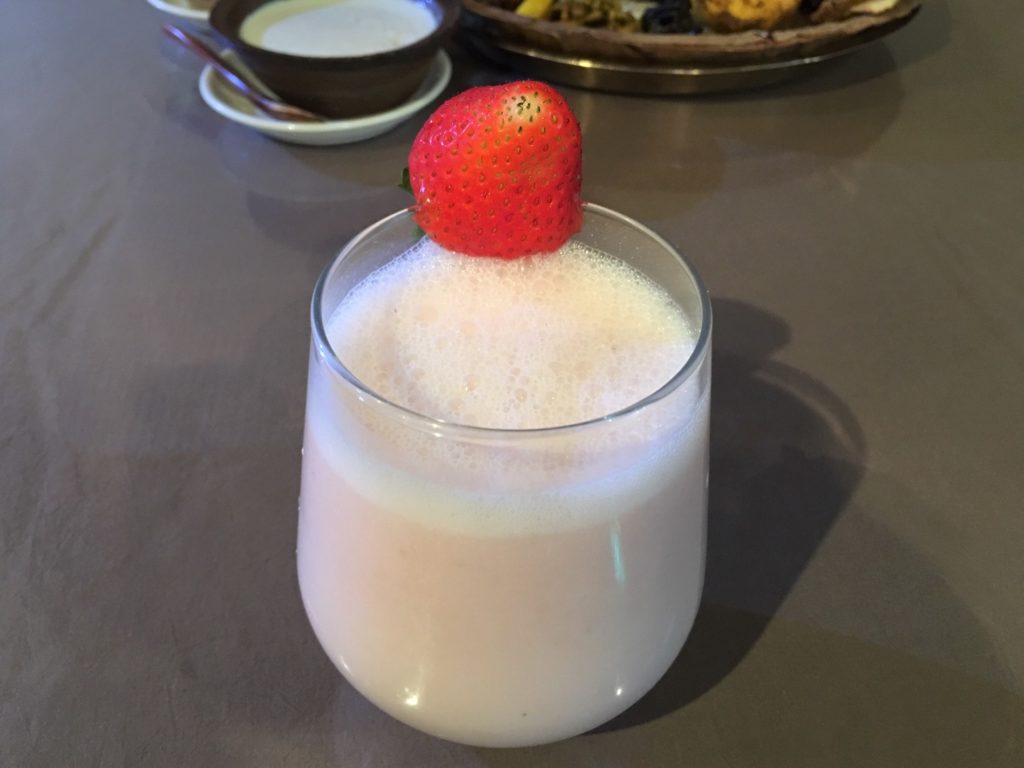
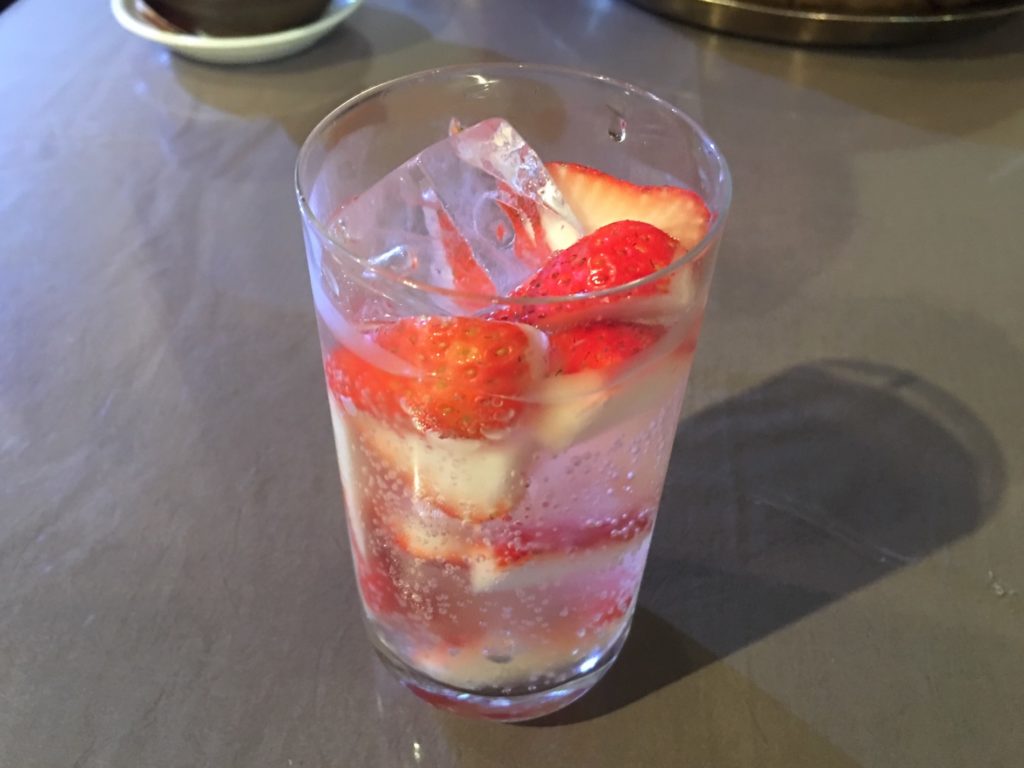 ズーズーダゥもデザートして添えられ、
ズーズーダゥもデザートして添えられ、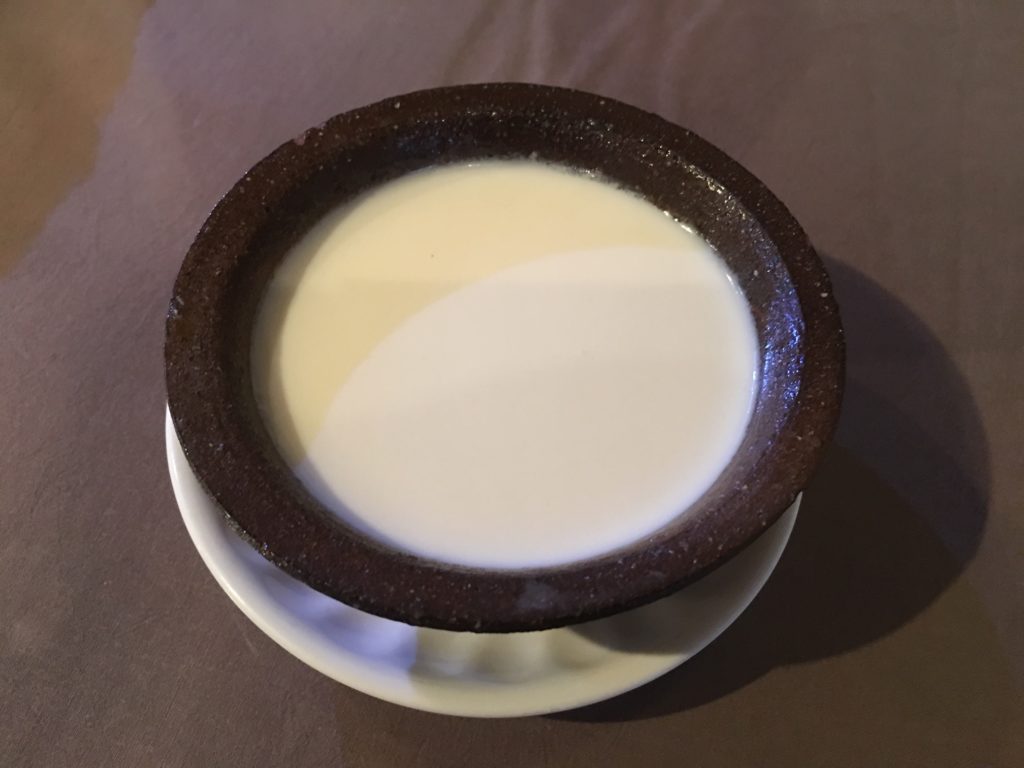 ヒマラヤ岩塩と黒糖入りの紅茶カロチヤも頂きました。
ヒマラヤ岩塩と黒糖入りの紅茶カロチヤも頂きました。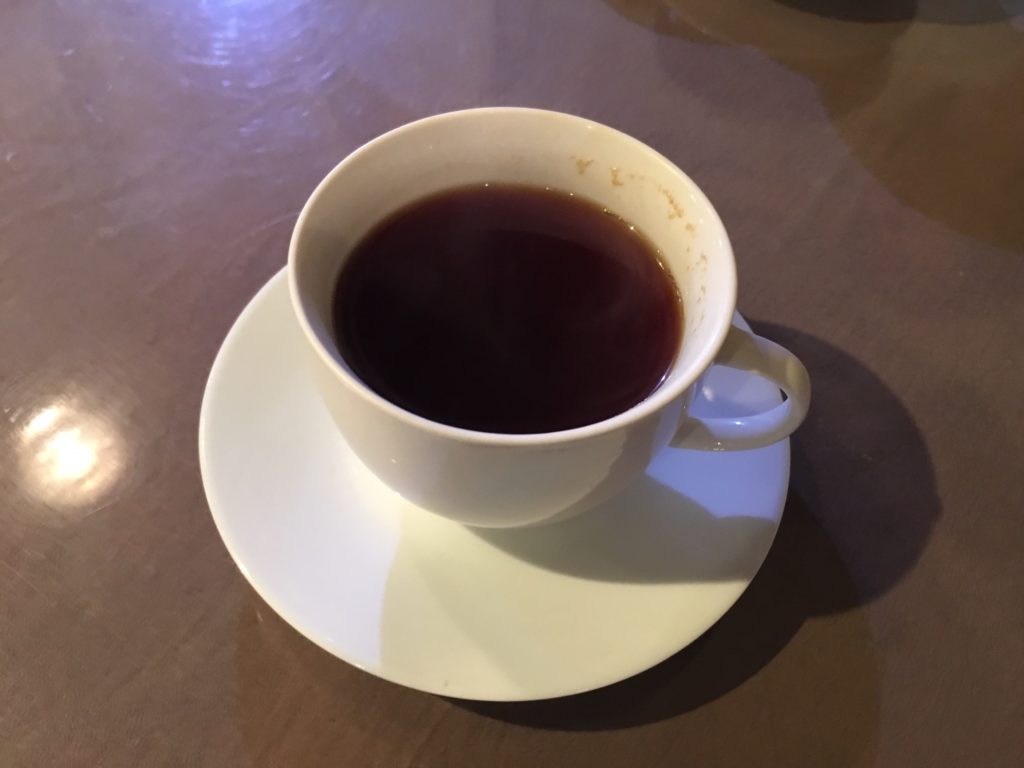
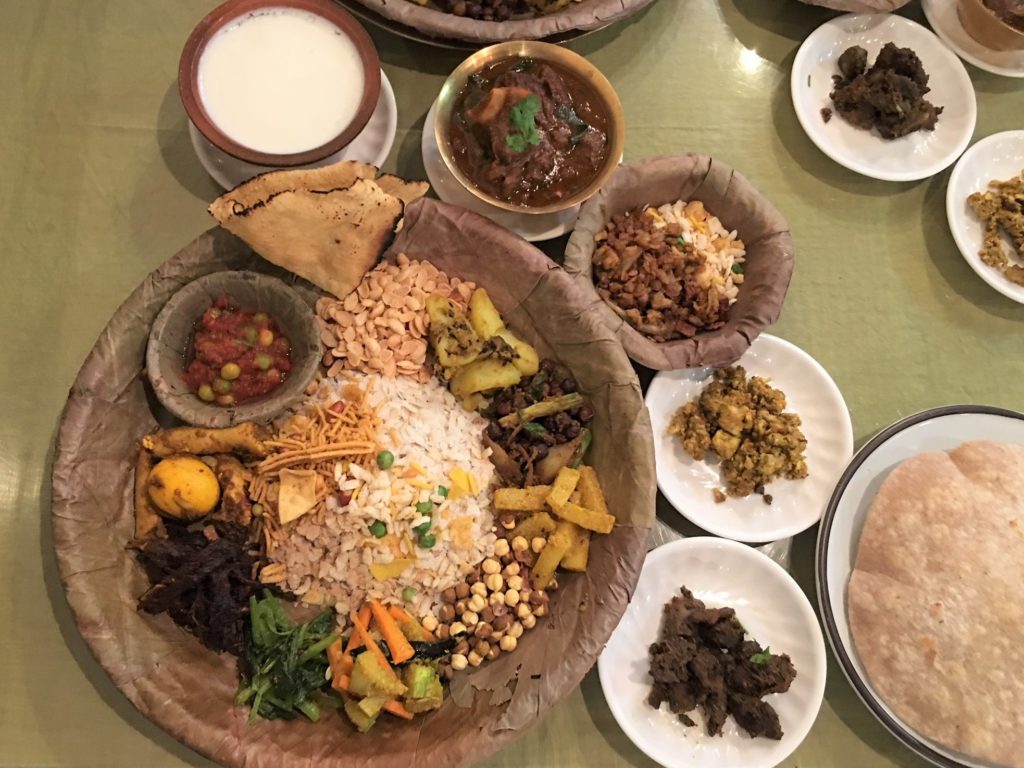
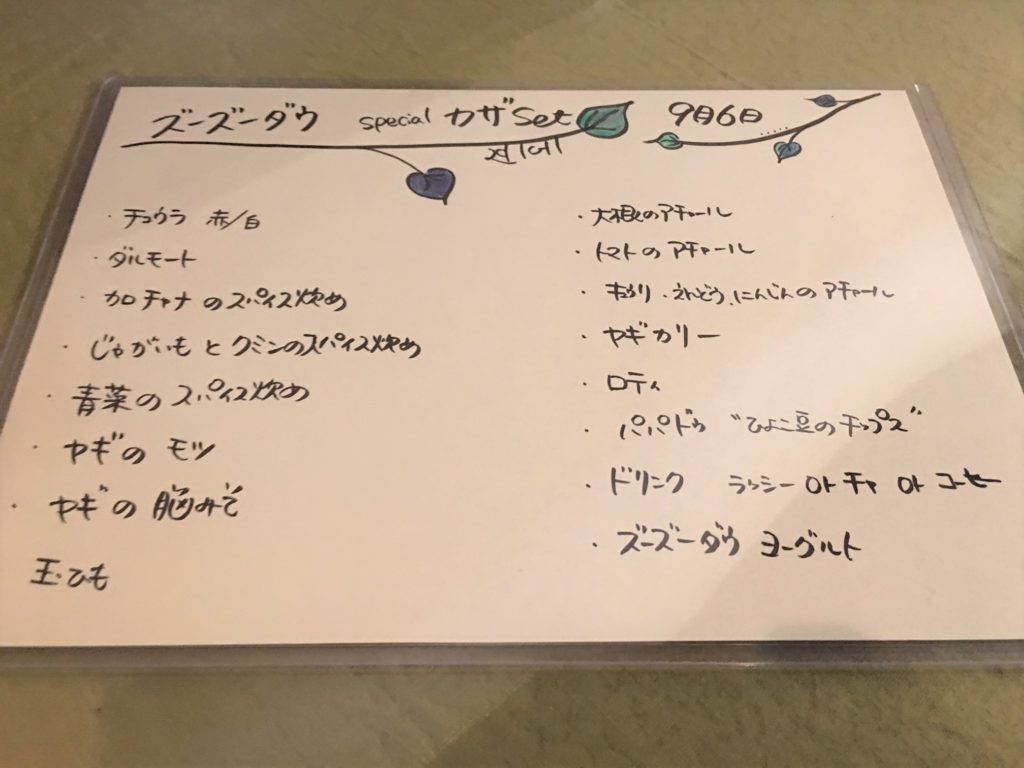 先ずはロキシーでスタートし、後半は他のお客様が持って来て下さったにごり酒で、チャンの気分で楽しみました。
先ずはロキシーでスタートし、後半は他のお客様が持って来て下さったにごり酒で、チャンの気分で楽しみました。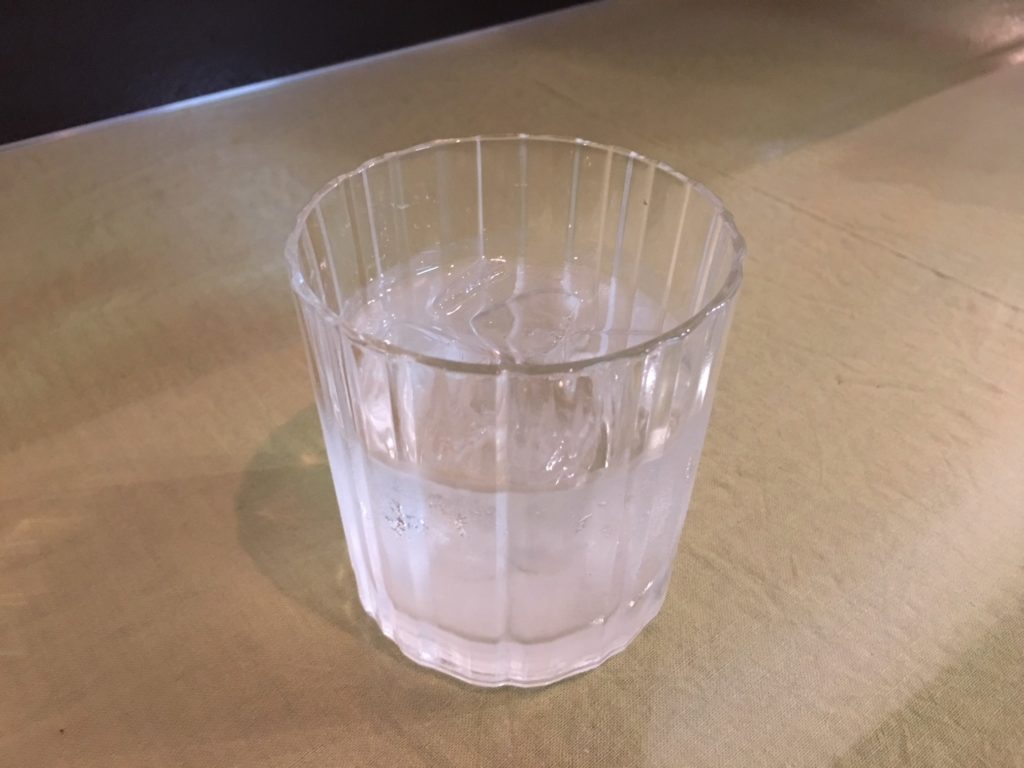 メインのお皿だけでも目移りする料理の数々です。
メインのお皿だけでも目移りする料理の数々です。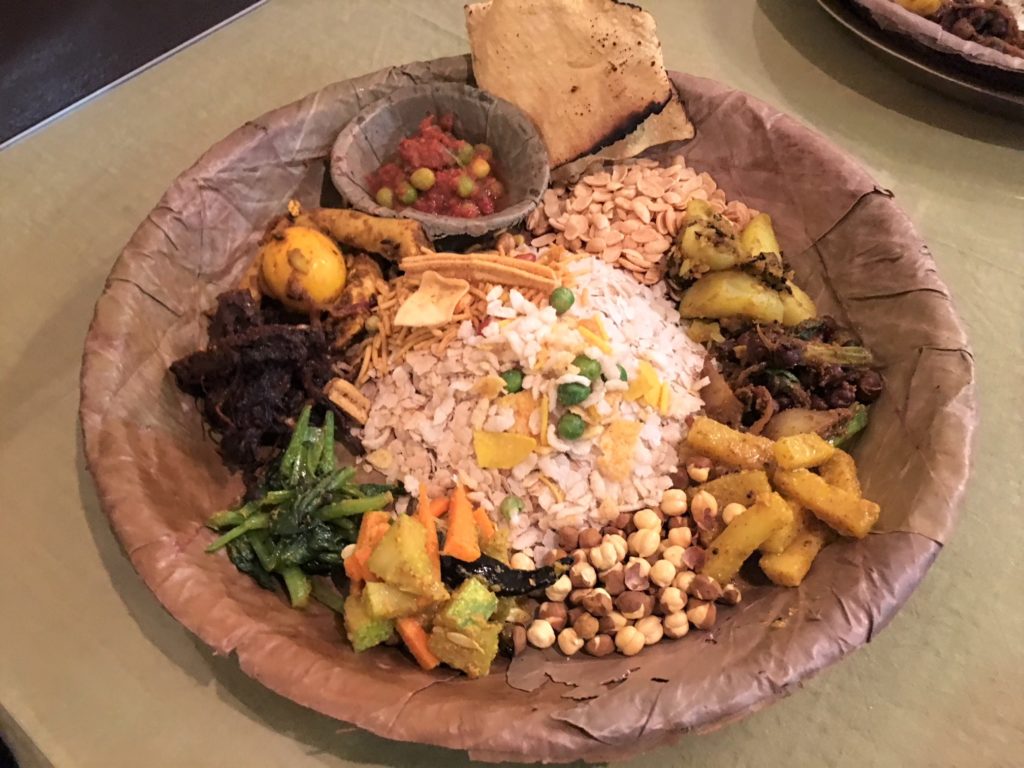 上の写真で12時の位置のパパドゥから時計回りに
上の写真で12時の位置のパパドゥから時計回りに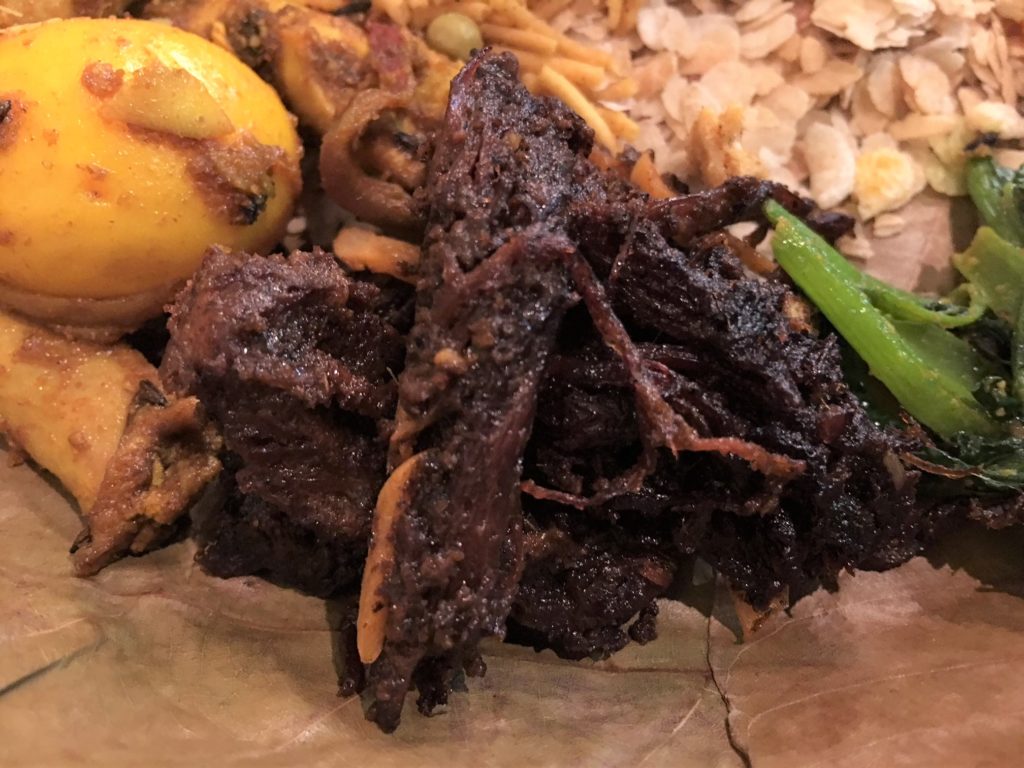 ● 玉ひものスパイス炒め
● 玉ひものスパイス炒め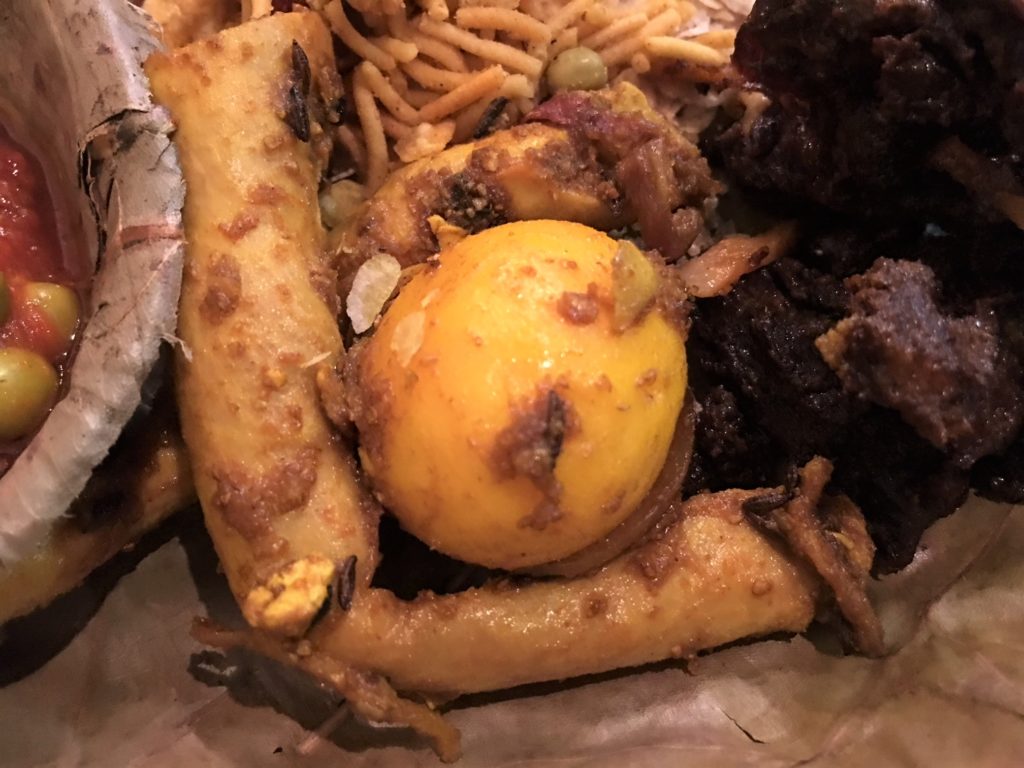 ● トマトのアチャール
● トマトのアチャール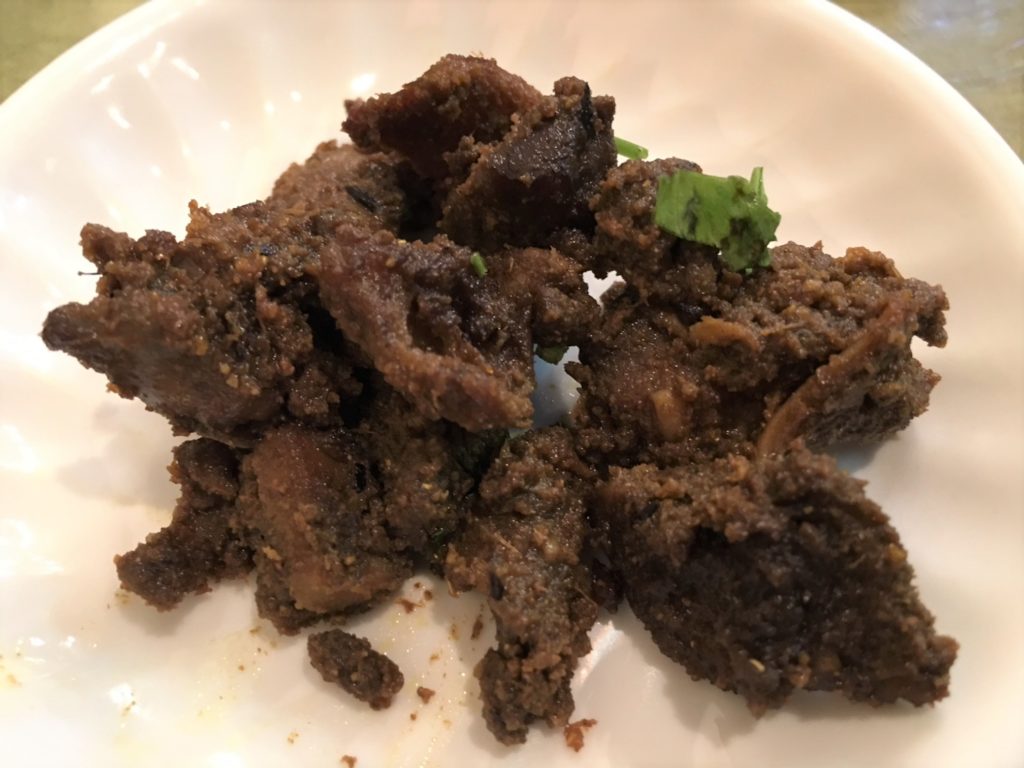 ● 山羊の脳
● 山羊の脳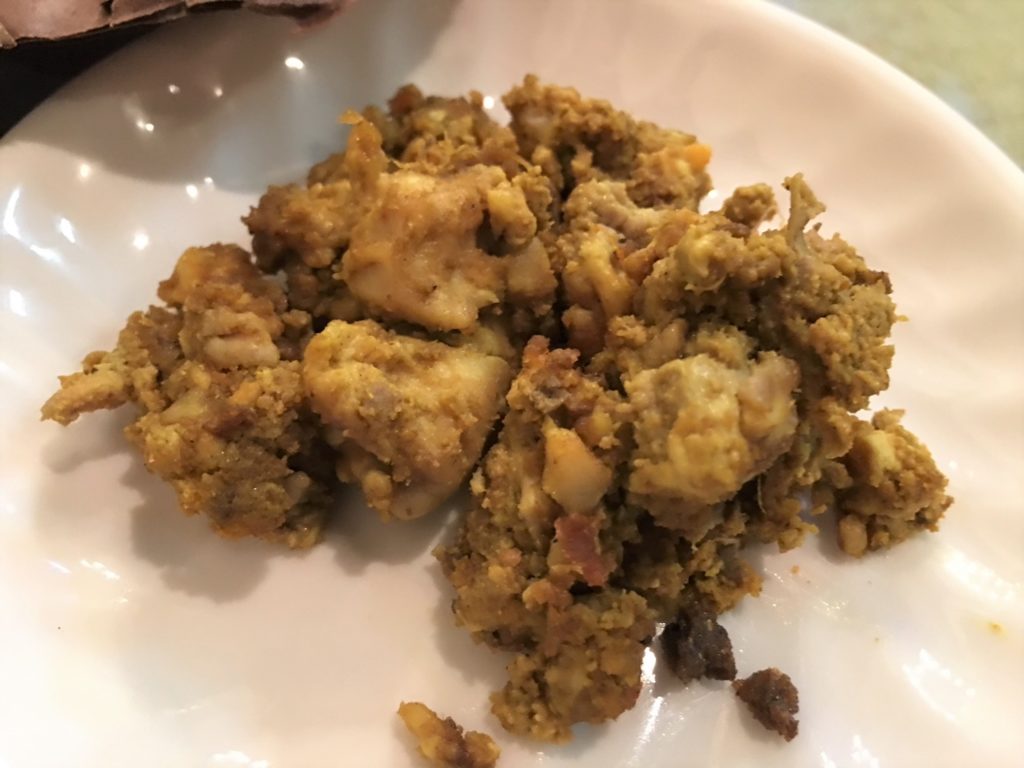 ● 赤チウラ、卵、エシャロット炒めと、ブジャ
● 赤チウラ、卵、エシャロット炒めと、ブジャ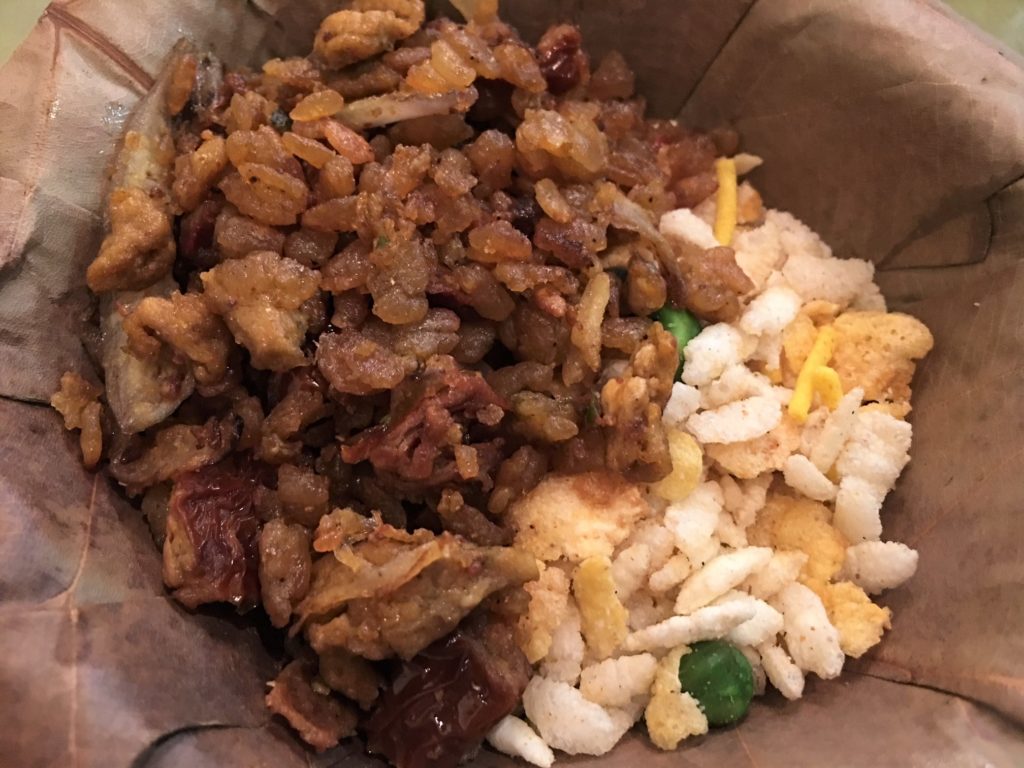 ● 骨付き山羊のカレー
● 骨付き山羊のカレー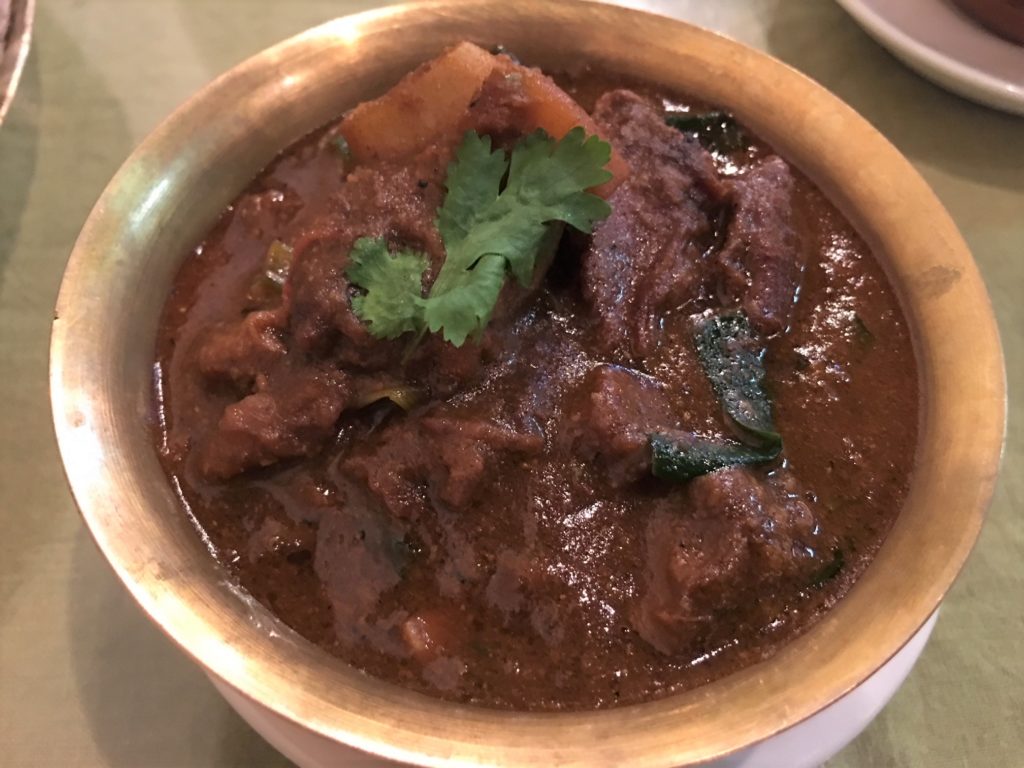 ロティとデザートのズーズーダゥも添えてあります。
ロティとデザートのズーズーダゥも添えてあります。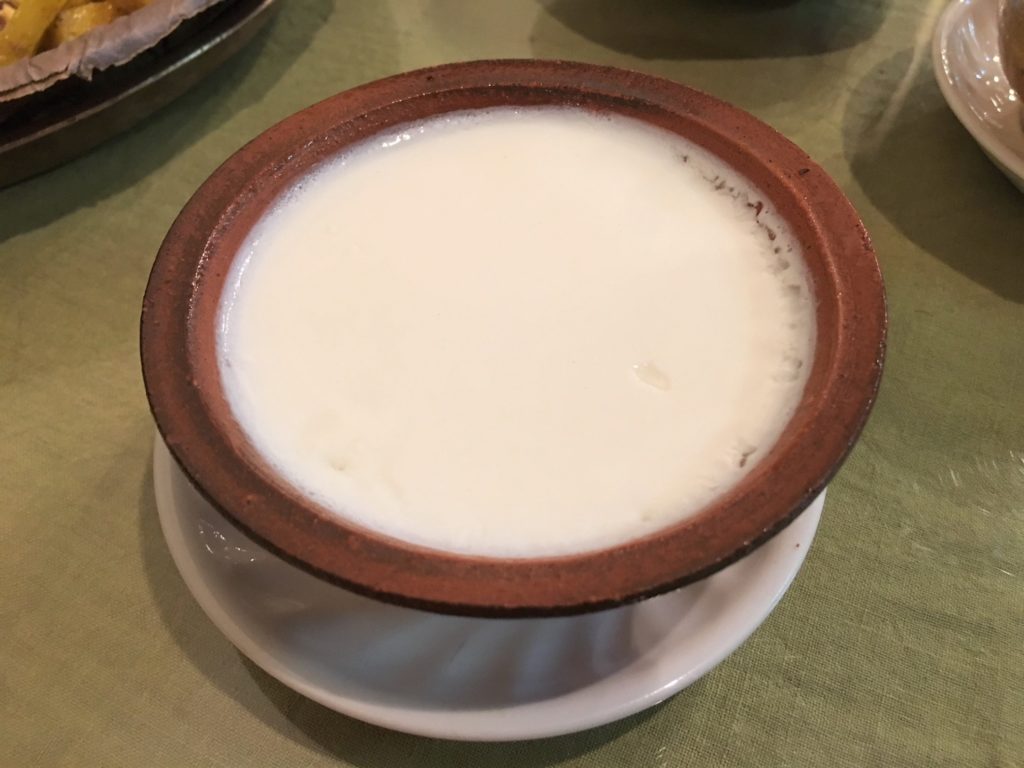 最後にチヤも頂いて帰りました。
最後にチヤも頂いて帰りました。 中央の2色のチウラを取り囲むように、10時の位置のダヒから時計回りに、
中央の2色のチウラを取り囲むように、10時の位置のダヒから時計回りに、 猪のブトン(肝、肺、胃)、
猪のブトン(肝、肺、胃)、 トウモロコシのアチャール、
トウモロコシのアチャール、 じゃが芋のアチャール、
じゃが芋のアチャール、

 ロキシーを使った山桃のカクテル、
ロキシーを使った山桃のカクテル、 山桃のラッシーなども登場し、
山桃のラッシーなども登場し、 まさしくお祭りの宴の体を成しており、主役がダヒチウラであったことを忘れてしまいそうでした。
まさしくお祭りの宴の体を成しており、主役がダヒチウラであったことを忘れてしまいそうでした。
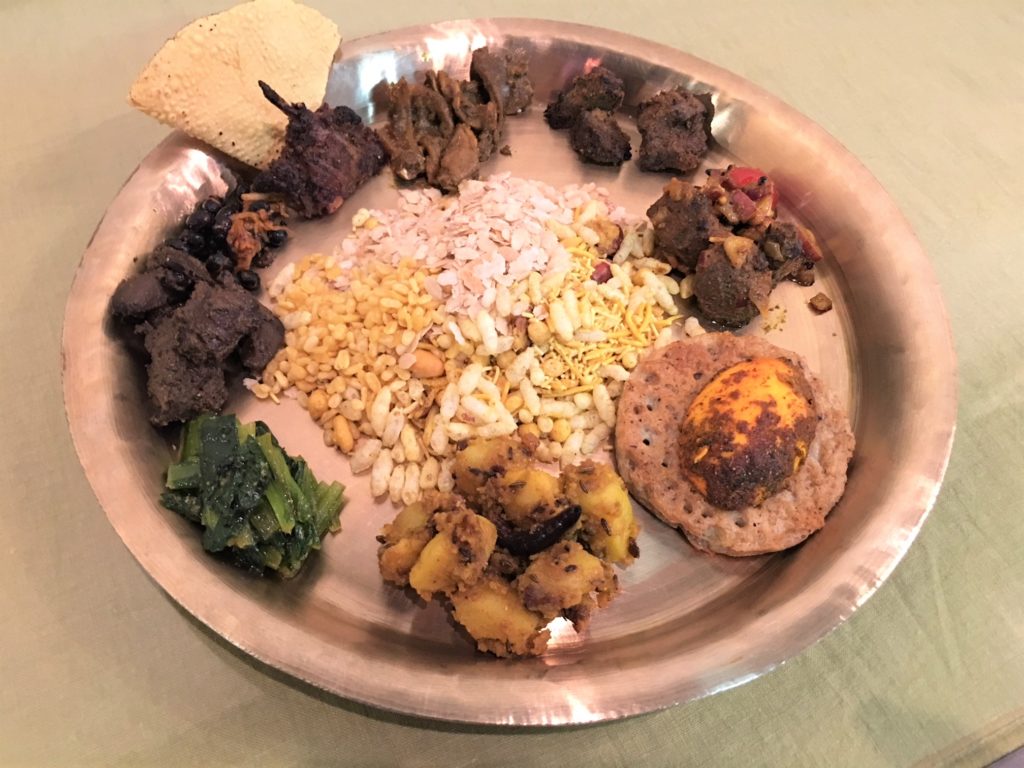
 中央のチウラChiura、ブジャBhuja、ダルマートDal Mothを取り囲むように、ターリー左側9時の位置から時計回りに
中央のチウラChiura、ブジャBhuja、ダルマートDal Mothを取り囲むように、ターリー左側9時の位置から時計回りに 飲み物は、そのお客様が持参下さった沖縄の泡盛でジョインカッテを作って頂きました。
飲み物は、そのお客様が持参下さった沖縄の泡盛でジョインカッテを作って頂きました。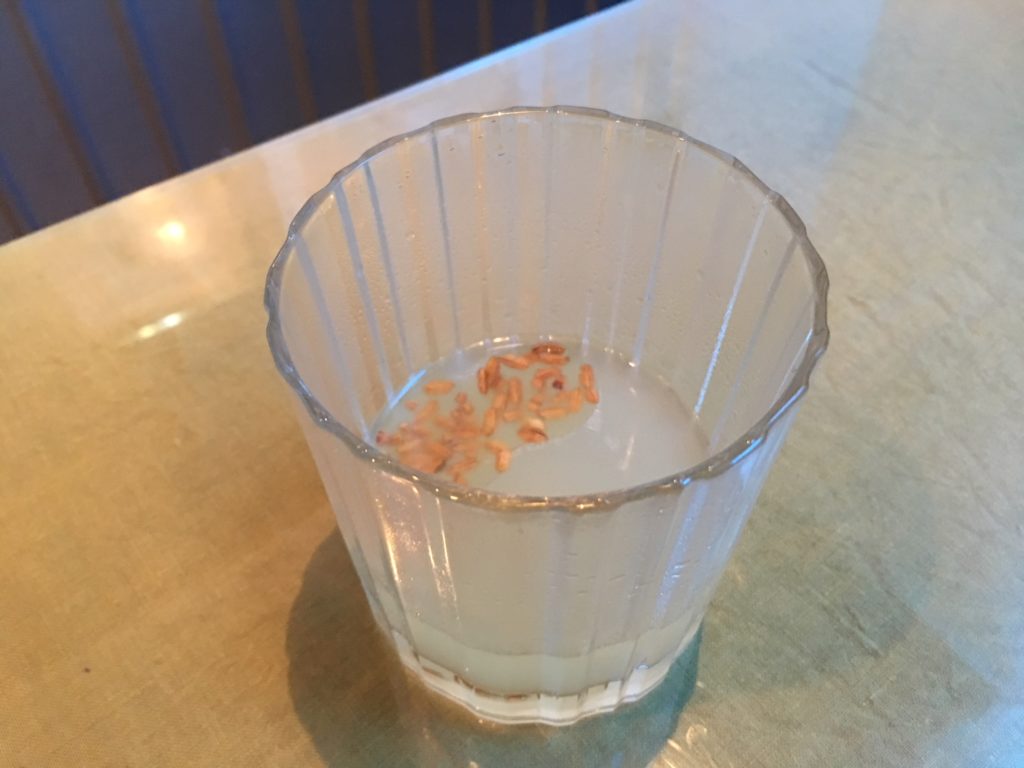 野生動物は、仏語でJibier、英語でGameですが、ネパール語では四つ足であればJangali Janavar ジャンガリ・ジャナワル、野生の鳥も含めるとPasupanchhi パスパンチだそうです。”Pasupanchhi ko Samay Bhaji”とでも呼べる美味しい一皿を頂きながら、ご一緒させて頂いた方々とお話をし、楽しい時間を過ごしました。
野生動物は、仏語でJibier、英語でGameですが、ネパール語では四つ足であればJangali Janavar ジャンガリ・ジャナワル、野生の鳥も含めるとPasupanchhi パスパンチだそうです。”Pasupanchhi ko Samay Bhaji”とでも呼べる美味しい一皿を頂きながら、ご一緒させて頂いた方々とお話をし、楽しい時間を過ごしました。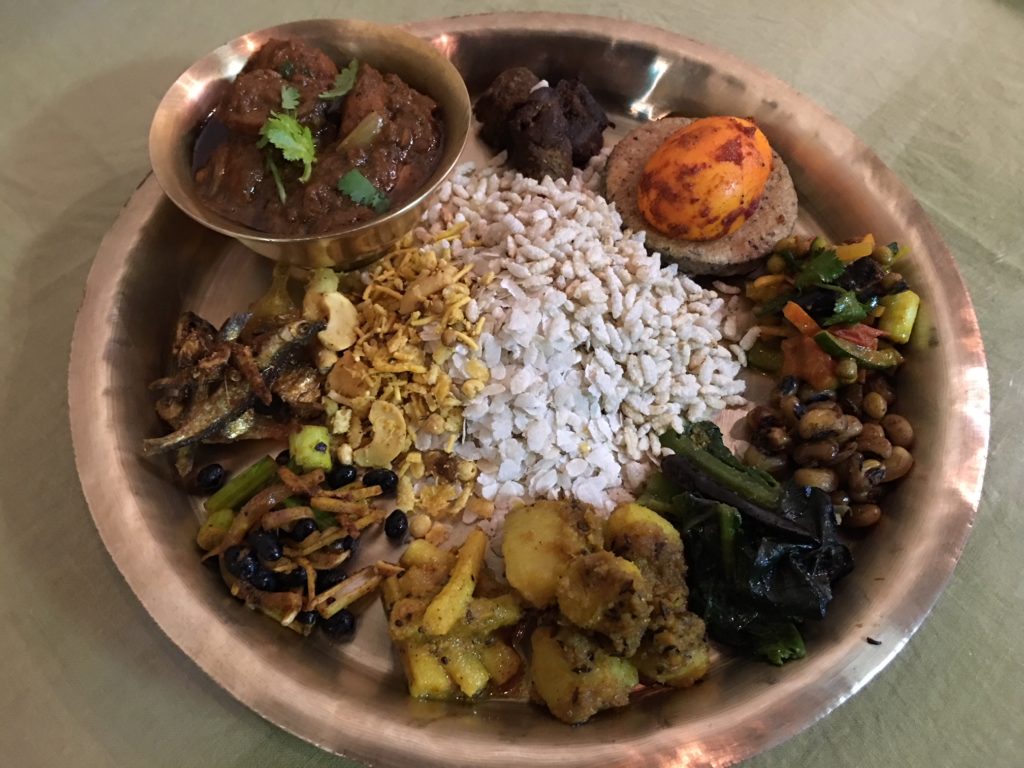 写真11時方向のカトリに入った
写真11時方向のカトリに入った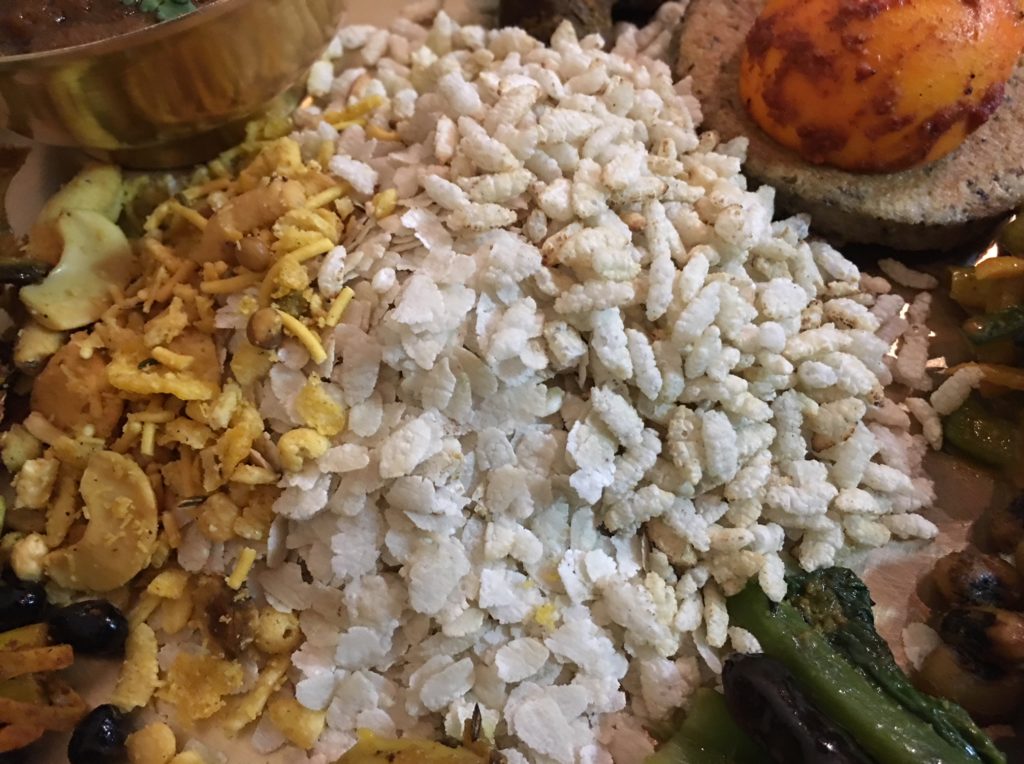

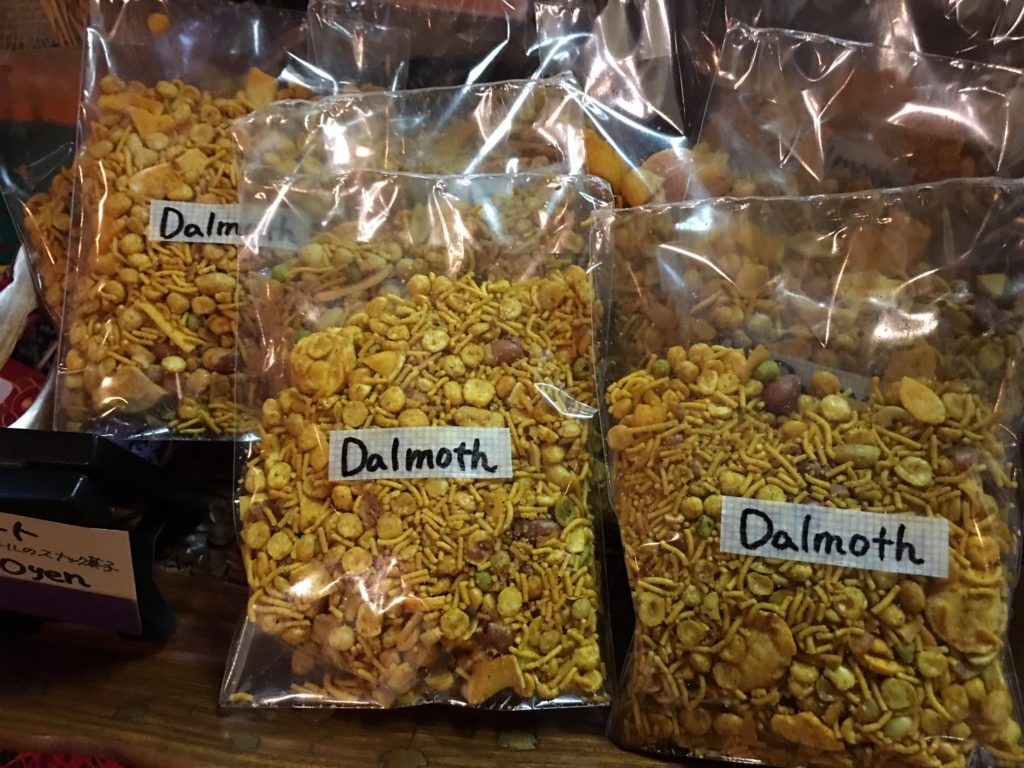 今回供されたサマエバジセットには、ロティかナンが付き、先週末のスペシャルダルバートから再登場のズーズーダゥJuju Dhauも頂くことが出来ます。オプションとして水牛のスクティSukuti、マトンのチョイラChhoilaが用意されていました。折角ですので、どちらもお願いすると、豪華ディナーとなりました。
今回供されたサマエバジセットには、ロティかナンが付き、先週末のスペシャルダルバートから再登場のズーズーダゥJuju Dhauも頂くことが出来ます。オプションとして水牛のスクティSukuti、マトンのチョイラChhoilaが用意されていました。折角ですので、どちらもお願いすると、豪華ディナーとなりました。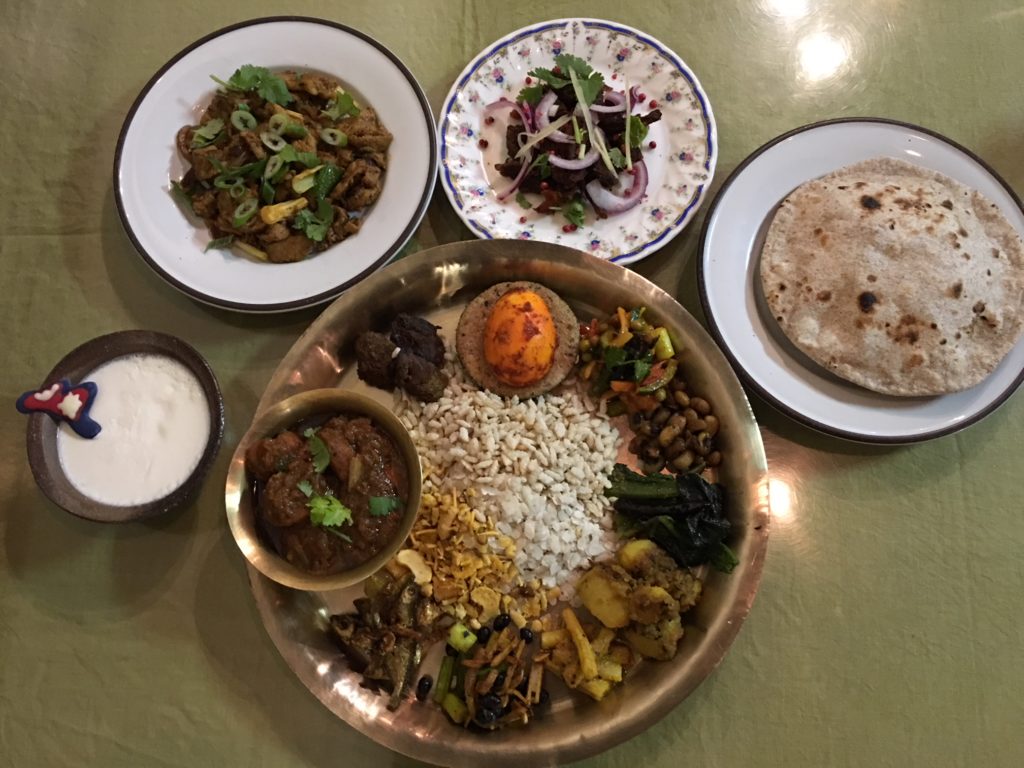
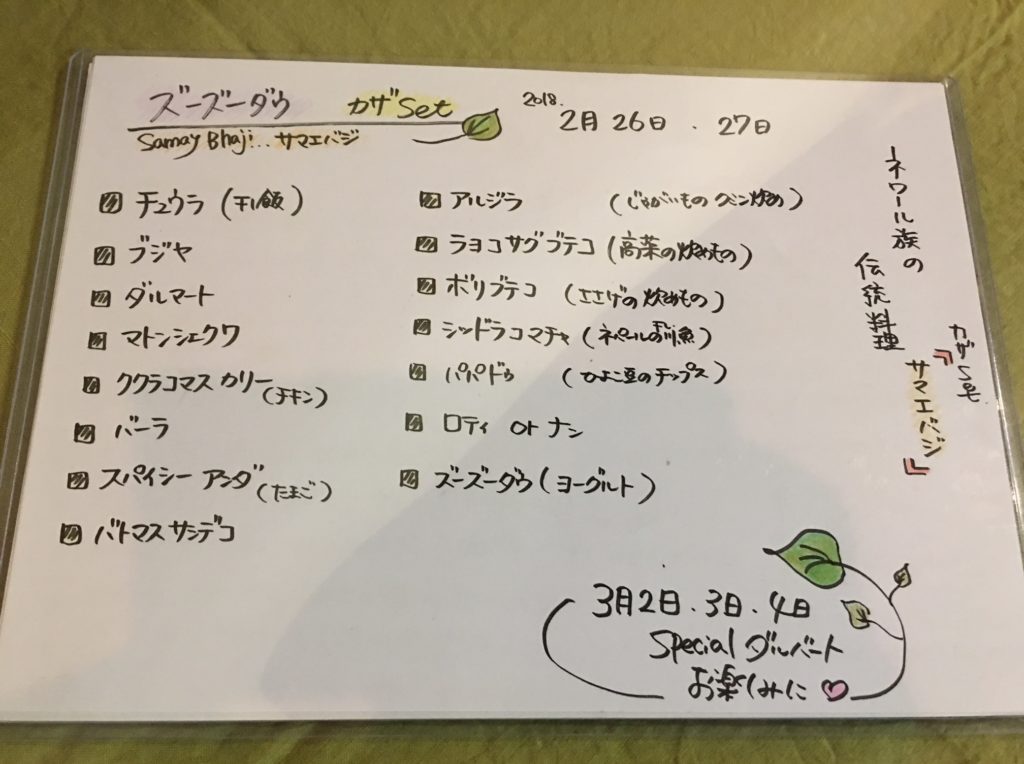
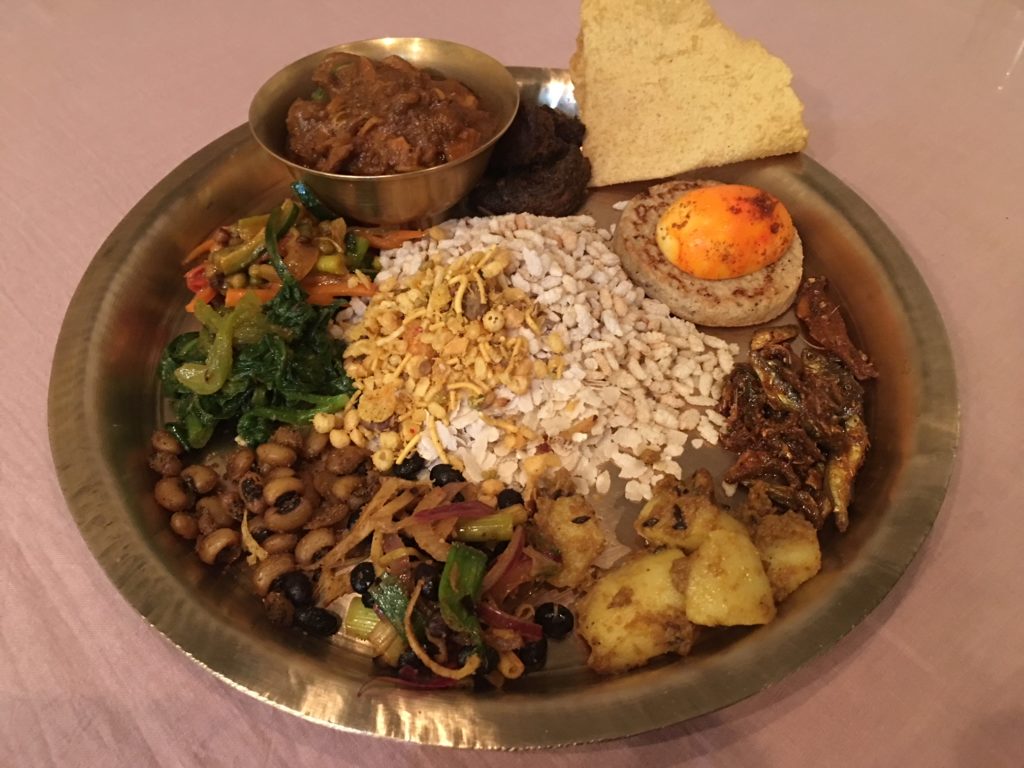 お店で頂ける料理の数々は
お店で頂ける料理の数々は あまりお腹が空いていなかったこともあり、サマエバジセットNewari Samaebaji Setをお願いしました。
あまりお腹が空いていなかったこともあり、サマエバジセットNewari Samaebaji Setをお願いしました。 店員さんに辛いですが構いませんかと尋ねられました。店内には、店員さんとお客さん合わせて10名でしたが、他の9名は皆ネパール人で、新大久保店と同じく、ここは日本?ネパール?という感覚にさせていただきました。
店員さんに辛いですが構いませんかと尋ねられました。店内には、店員さんとお客さん合わせて10名でしたが、他の9名は皆ネパール人で、新大久保店と同じく、ここは日本?ネパール?という感覚にさせていただきました。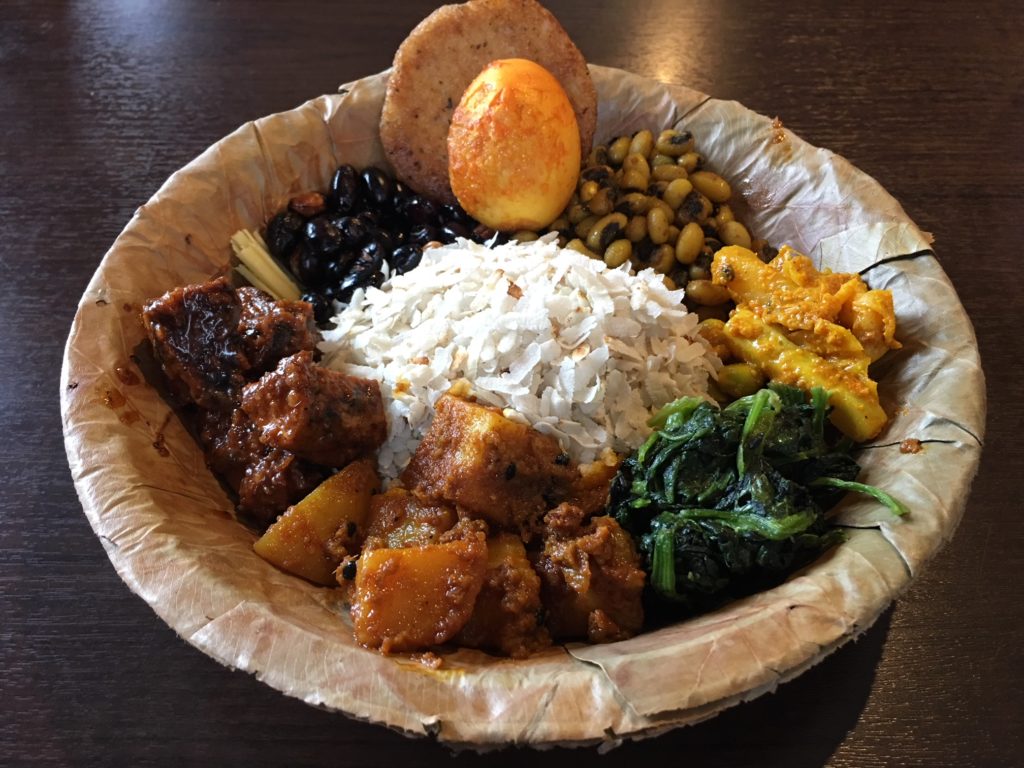
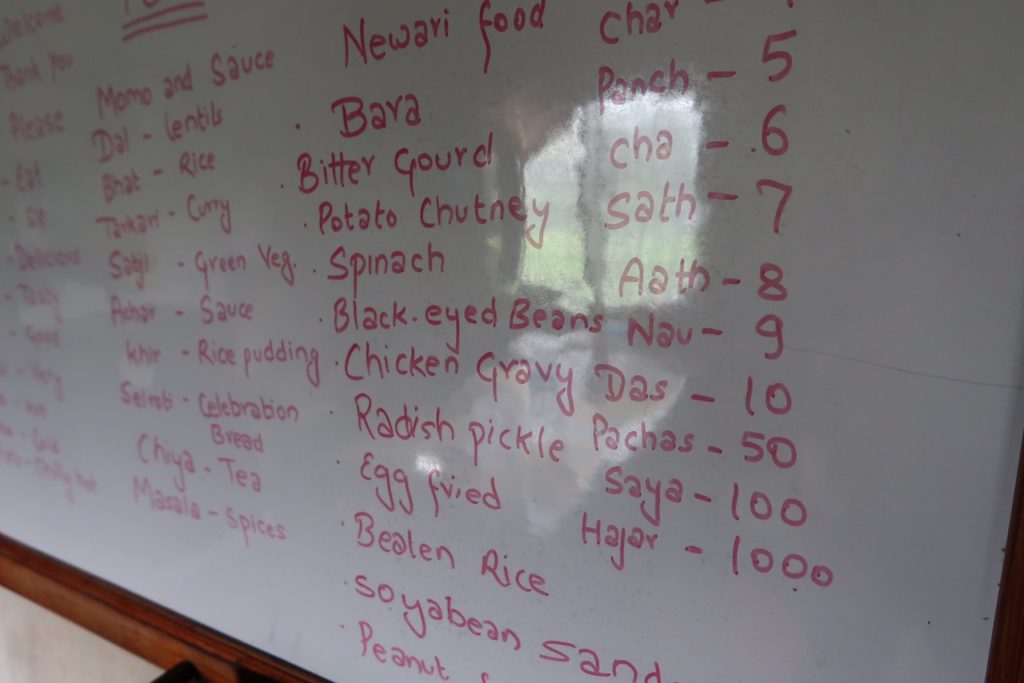 前もってネワール料理に大変興味が有る旨をメールでやり取りしていたので、ネワール族のおもてなし料理、サマエバジSamay Bhajiを作る様です。ここからは講師が娘さんに交代です。種類が多いので次から次へと野菜をカットしながら、コンロで調理です。合間にスパイスをミキサーにかけたり、
前もってネワール料理に大変興味が有る旨をメールでやり取りしていたので、ネワール族のおもてなし料理、サマエバジSamay Bhajiを作る様です。ここからは講師が娘さんに交代です。種類が多いので次から次へと野菜をカットしながら、コンロで調理です。合間にスパイスをミキサーにかけたり、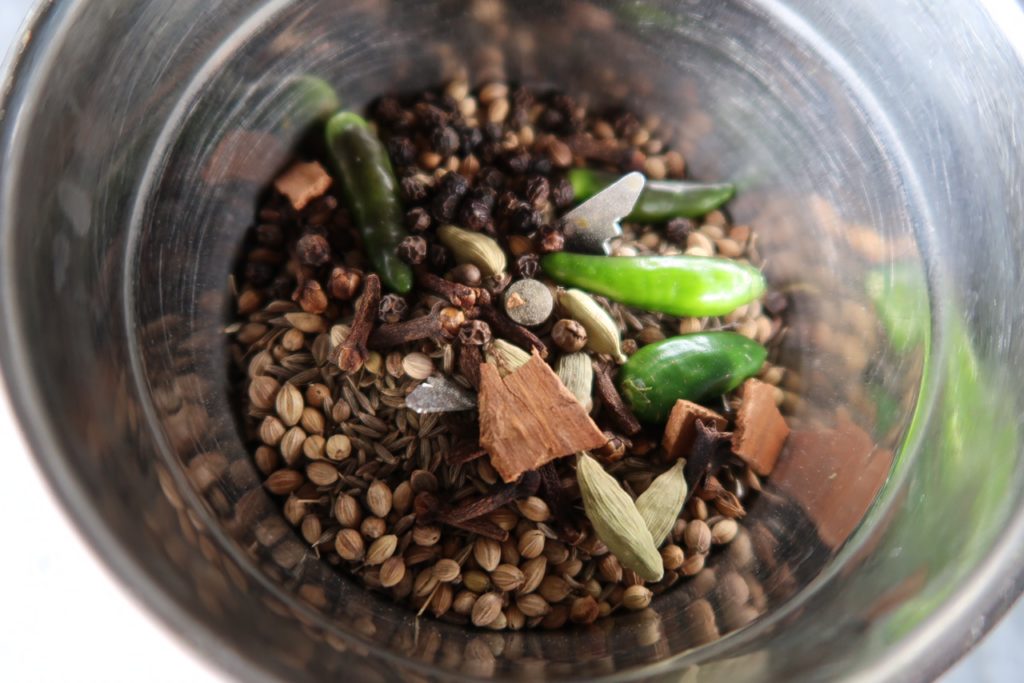 グラインダーで用意したりします。後でレシピをメールで送って貰えるとのことですので、詳細のメモを取る必要が無く、娘さんの指示のまま動いていると、次から次へと出来上がっていきます。
グラインダーで用意したりします。後でレシピをメールで送って貰えるとのことですので、詳細のメモを取る必要が無く、娘さんの指示のまま動いていると、次から次へと出来上がっていきます。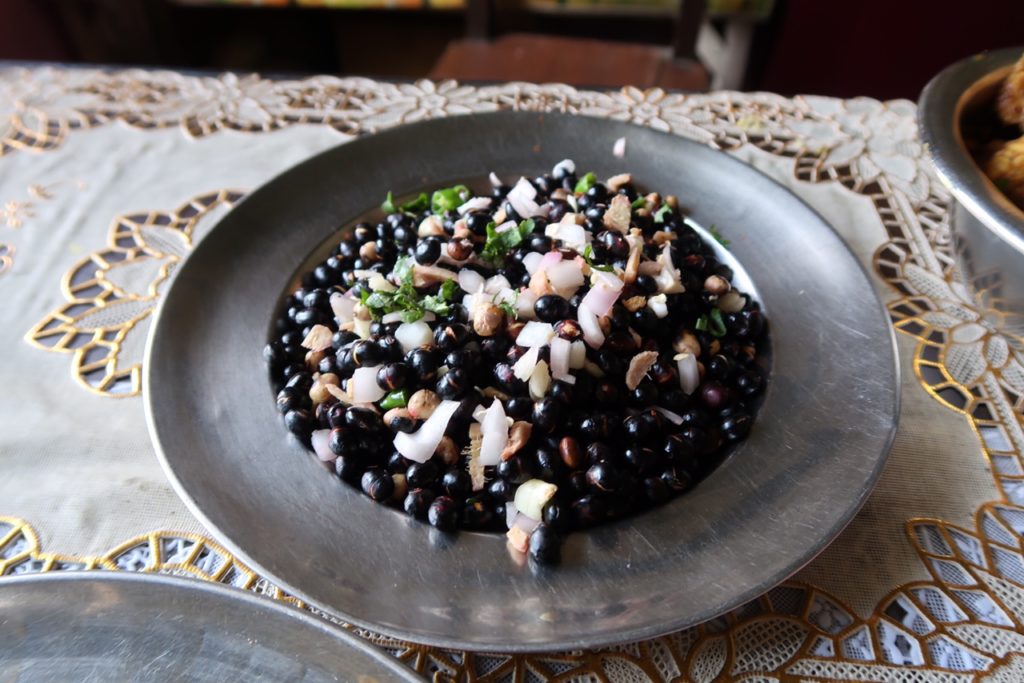 Badam sadeko バダムサデコ (Peanuts Sankeko)
Badam sadeko バダムサデコ (Peanuts Sankeko)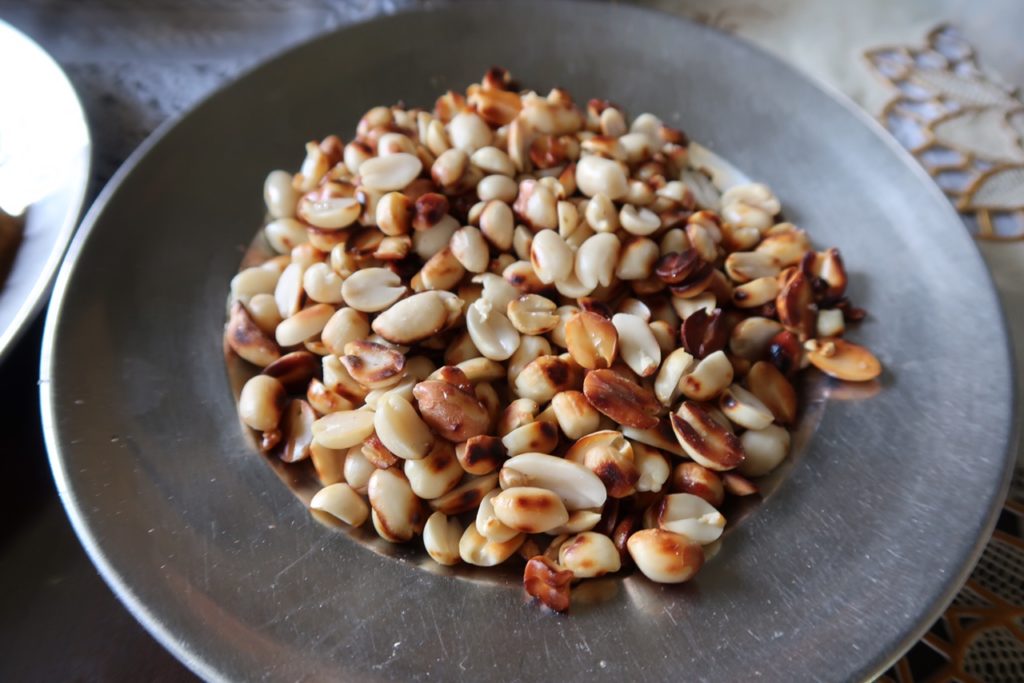 Karela sadeko カレラサデコ (Bitter Gourd Chutney)
Karela sadeko カレラサデコ (Bitter Gourd Chutney)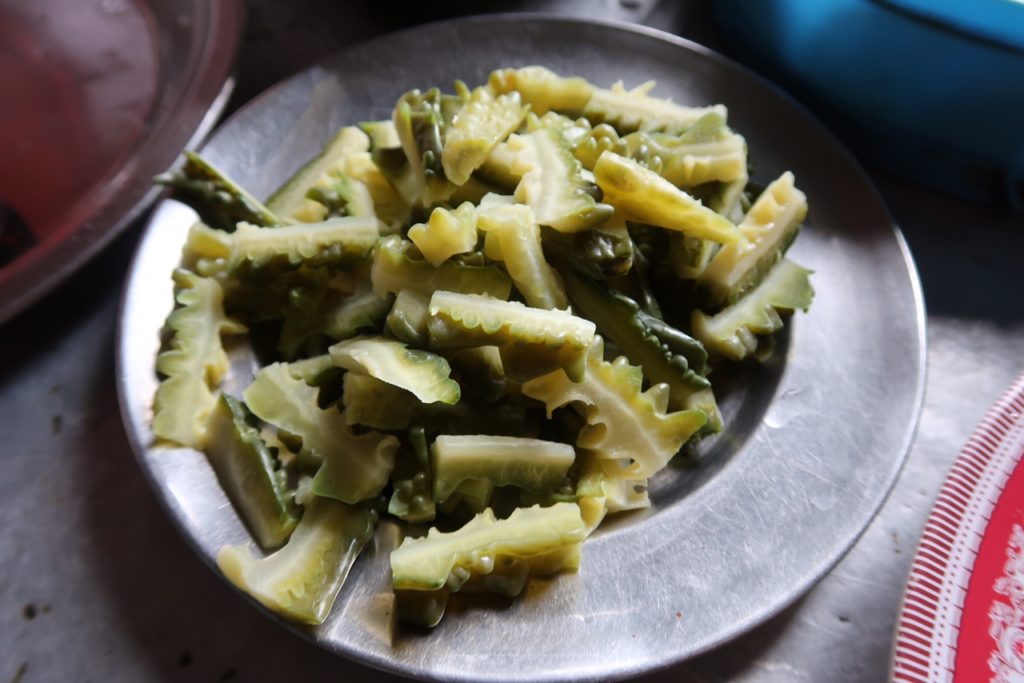 茹でて胡麻をまぶし、各種香辛料を加えます。
茹でて胡麻をまぶし、各種香辛料を加えます。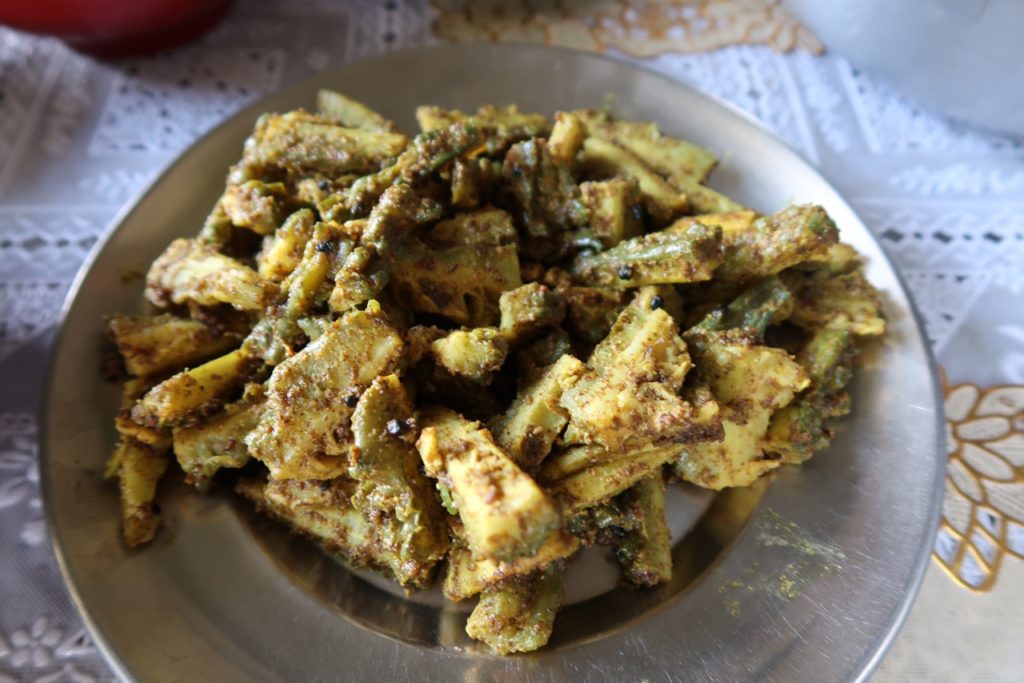 Kakro ko achar カクロコアチャール (Radish Pickle)
Kakro ko achar カクロコアチャール (Radish Pickle)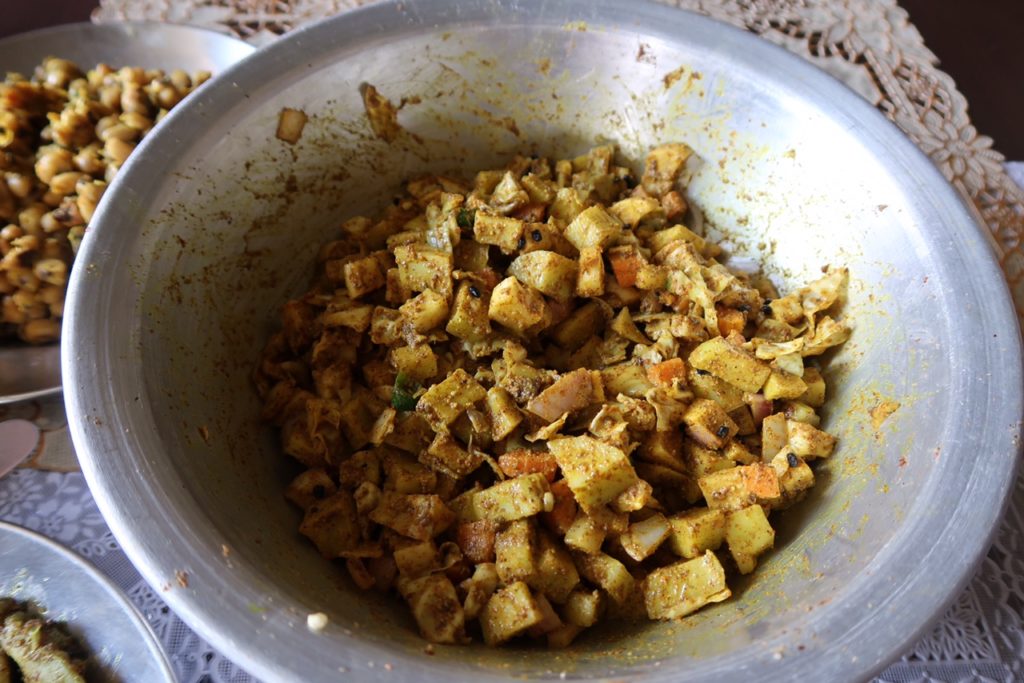
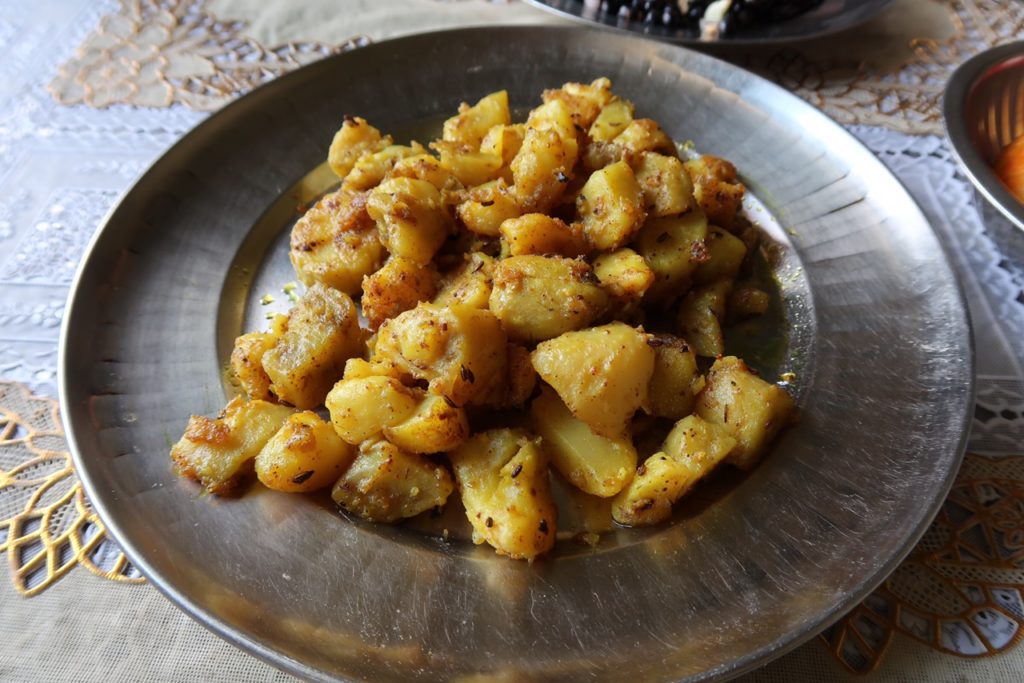
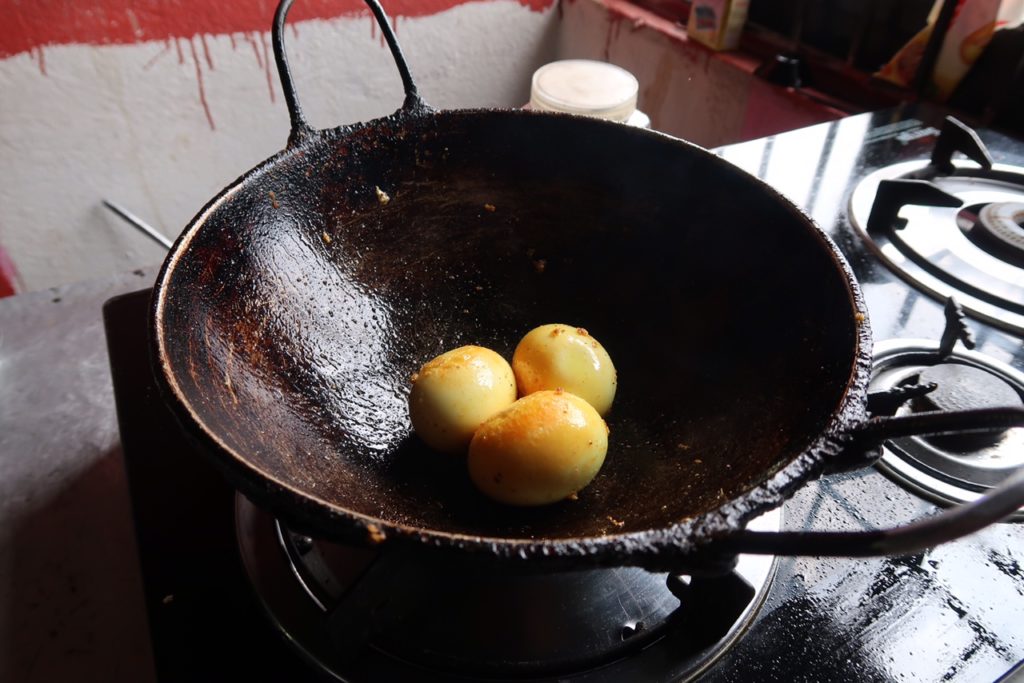
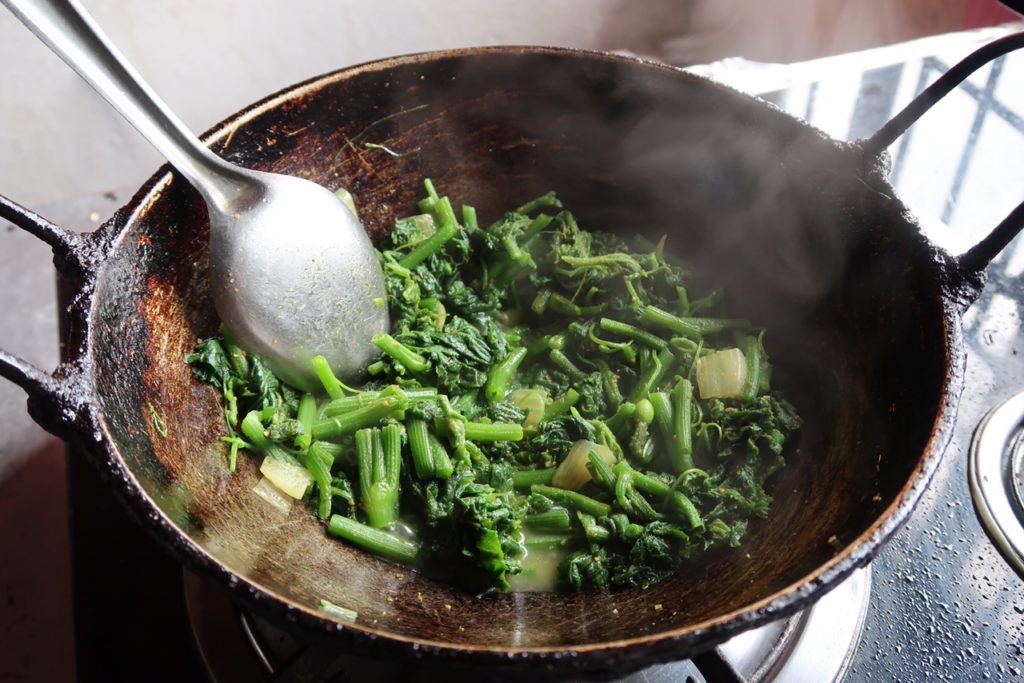
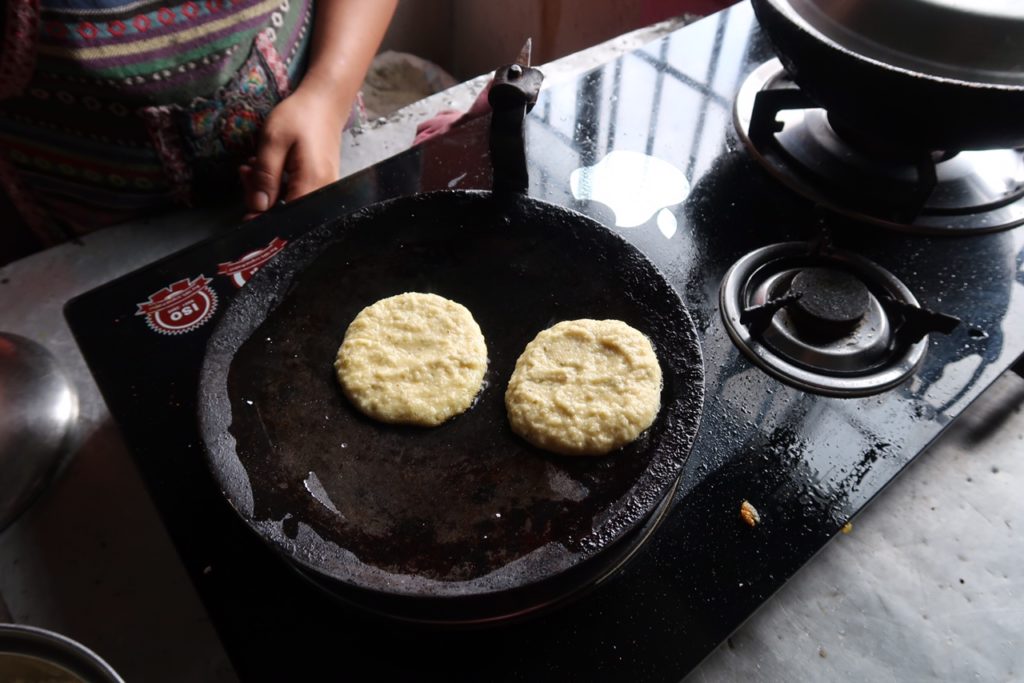

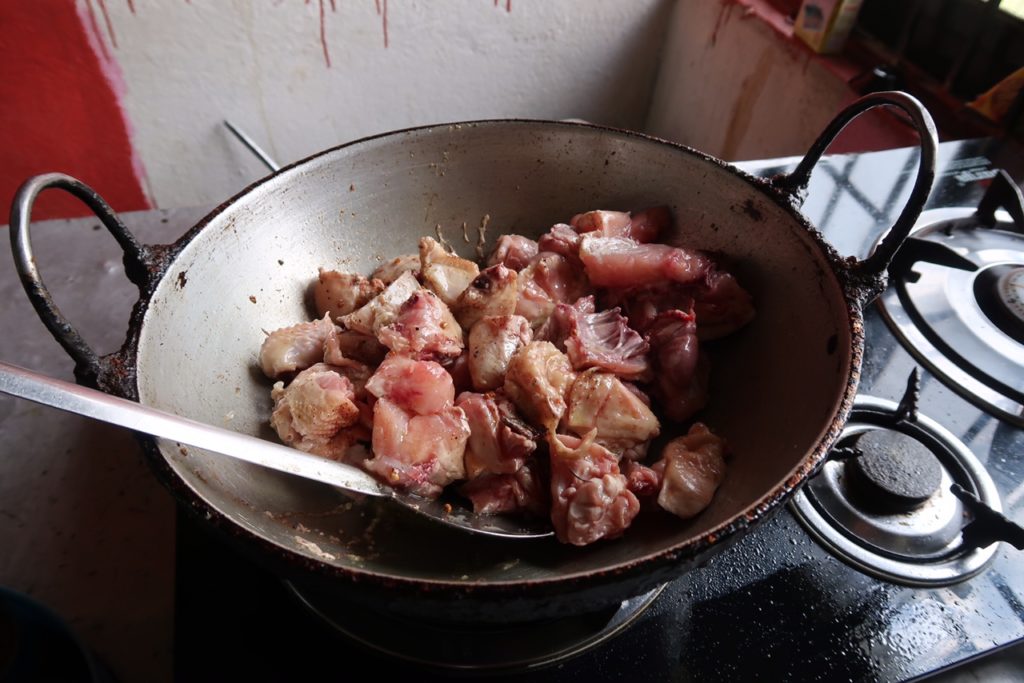 途中までのものがKuhkura bhuteko ククラブテコ (Chiken Fried)で、
途中までのものがKuhkura bhuteko ククラブテコ (Chiken Fried)で、 そこにトマトや水を加え煮ていくとまた別の一品Kuhkura ko jhol ククラコジョルとなります。
そこにトマトや水を加え煮ていくとまた別の一品Kuhkura ko jhol ククラコジョルとなります。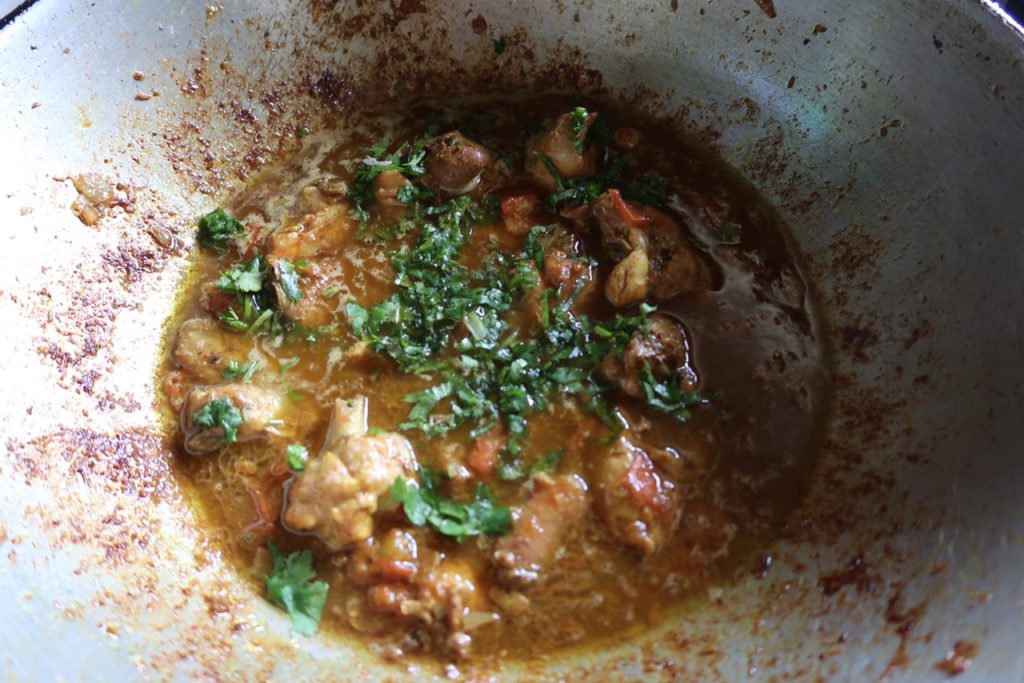
 出来上がったものをテーブルに並べてみると、結構な品数です。
出来上がったものをテーブルに並べてみると、結構な品数です。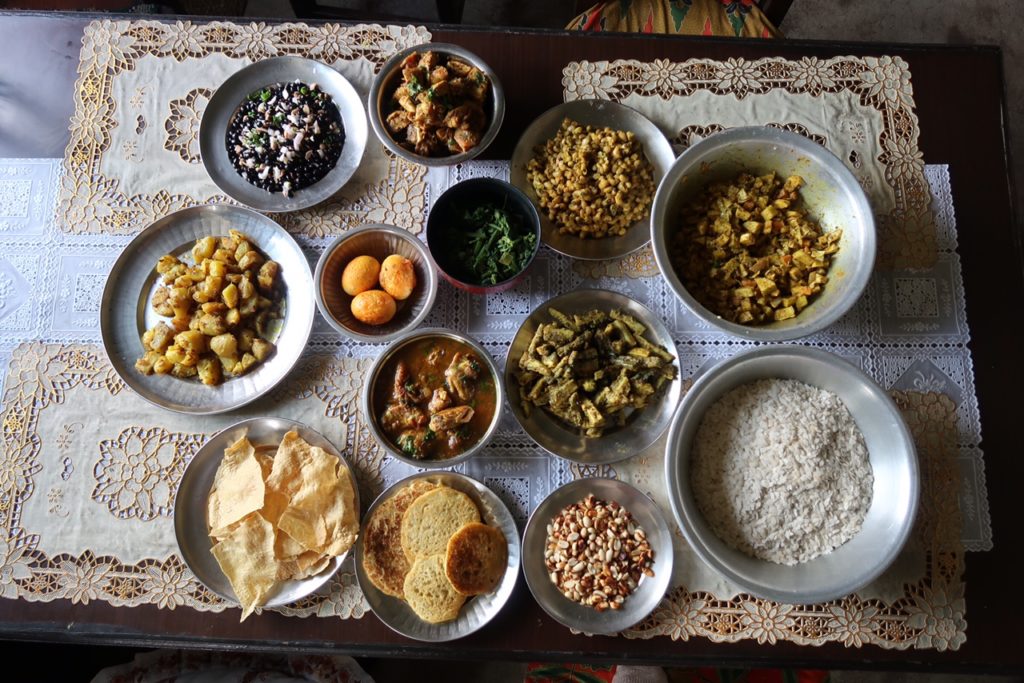
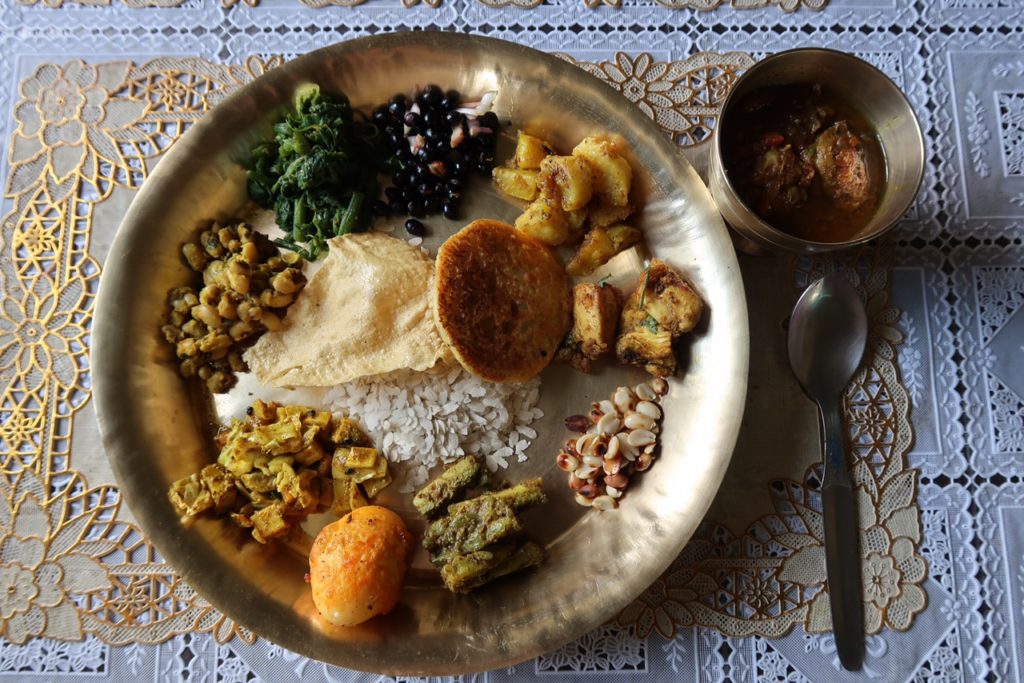 家族の皆さんや、丁度やって来られた送迎の車の運転手さんと一緒に頂きました。
家族の皆さんや、丁度やって来られた送迎の車の運転手さんと一緒に頂きました。